#''well whats the point in using super sonic when this other Better transformation exists''
Explore tagged Tumblr posts
Text
not gonna lie i really hope that the blue eyes super sonic is 1 just a temporary thing (which it probably is im not expecting this to be a permanent change at all) and 2 isnt like. Super Sonic But More Powerful Or Whatever. obviously i think transformations are fun but imo they should mostly just introduce fun new abilities that sonic wouldnt normally have or show what would happen if he used the power of whatever important objects/gods/etc are in that game. not try harder and harder to be stronger than previous transformations each time. super sonic is Already supposed to be the strongest most powerful version of sonic and in my opinion introducing other forms that are just "super sonic but better" makes super sonic feel kinda. pointless? weaker? idk if what im saying makes sense at all.. to be clear it wouldnt be the end of the world to me if they did this its just not something i really Want them to do
#my guess is that its like. cyber energy messing with sonic's super form somehow#if this is supposed to be a super sonic but more powerful thing then they should make it temporary for sure#like the circumstances that caused it would be extremely difficult if not impossible to replicate again#that or sonic just needed to use cyber energy for this specific enemy for whatever reason#and this version of super sonic is only more useful than normal super sonic in certain situations#that way in future sonic media when they bring out super sonic it wont be like.#''well whats the point in using super sonic when this other Better transformation exists''#sonic frontiers#sonic frontiers spoilers
135 notes
·
View notes
Note
Hi I saw your old essay post from September 2024, back when the TF One film came out, and I just wanted to say I was one of the people who was very excited over the non-transforming model kits 😅 I did get my own! The big Optimus/Cogged Orion. I specifically wanted a toy that had a super accurate face to the movie and so I was happy that it existed.
I think the difference here is that as a collector of toys, I started out as a huge anime fan so I am very used to buying figurines that don't do anything in order to have the most screen accuracy - not even any articulation at all. As a new fan of TF, the fact that they don't transform doesn't bother me because I care more about what the character represents than something I can play with (though in this case you can because they're still very articulated, unlike anime figures besides figmas). I have a Yolopark "G1" mini non transforming Starscream model kit I got for $10 and I made him hold a tiny pride flag while pointing at me - I cared more about things like his face, wings, and overall accuracy to how I see Starscream in my mind (a silly little evil guy). I genuinely only cared about the fact that he looked very close to the cartoon for a cheap price. I have multiple transforming toys too, and they're fun, but since I don't transform them that often anyway (besides this $10 Galvatron I got that transforms in like less than a minute, I love fidgeting with him), I don't see one type of toy as better than the other.
This isn't really a rebuttal of your essay since your opinions are valid to your lived experiences, I just thought it was interesting how different our perspectives were for a few reasons - I am 21, and TF One was actually the first media I ever engaged with related to Transformers at all. I knew of the Michael Bay films but they didn't appeal to me at all when I was a child because they seemed totally mindless and sexist, and it wasn't until TF One that I even knew who ANY of the characters were (or that there were characters!?) beyond a vague concept of Optimus and Megatron - I went into it almost completely blind because they were promoting it with a free Sonic poster 😭. And it worked...since last September I have bought 7 toys and all of the Skybound comics...😅
I don't disagree that constant reboots and rehashes are definitely a symptom of capitalism (not wanting to lose trademarks, trying to maintain and create a new audience), and it's definitely kind of gross that there is that expectation that of course you should spend hundreds on our franchise - you grew up with it, right? But at the same time I actually kind of like that there are so many different versions of the same characters? I still get what you mean that there should still be a focus on creating new characters, of moving on, since I LOVED TF: The Movie. (Hot Rod/Rodimus is the best). If you haven't checked out the Skybound comics, they're definitely trying to rehash nostalgia with the character designs but they refuse to overly stick to overly used characters JUST for the sake of nostalgia and are willing to kill them off, including Bumblebee in the very first issue. Of course they might not be your thing anyway.
I also personally really loved the fact that Megatron and Optimus were friends first in TF One, and you could maybe attribute that to how I've seen very little superhero stuff, so instead of it seeming like an X-Men rehash it was totally fresh to me. (Well, mostly fresh, friends to enemies is pretty archetypal lol). I was...nine years old when X-Men: First Class came out, and my parents did not care for superheroes (I haven't seen a single Marvel movie and have only seen a few DC ones bc my friend's a fan for the first time last year), so I never even knew it existed until I saw people compare it to TF One. Planning to watch it soon, lol. The whole "OP and Megs were friends first" thing is very fanfiction-y, but if I'm being honest that's what I like about it... I never thought I would get so invested in robot slash but it's everywhere! And wonderful. (Sorry if that's something you dislike).
It isn't the only thing I like about the franchise: the sci-fi space opera vibe the 1986 film developed is awesome, and stuff that could only happen with robots like unique torture such as the "anti-personal mines" or empurata from IDW, the oppressive function based society also from IDW - TBH I think the Stalinist Megatron is cool...I mean like, fascist Megatron is fine (and I see TF One Megatron as a fascist), but the Megatron as a character I want to spend time thinking about and picking apart is the Megatron who wrote poetry and manifestos before being a war criminal, the universal greeting, what forms gender and recreational sex take in a society without sexual reproduction or sexual dimorphism - mostly a fanon thing obviously) but besides all that honestly...if it wasn't for the slash potential I probably wouldn't have gotten invested LMFAO. Yep. I'm just going to own it. I've had a great time with it. In my defense, I'm a lesbian! #representationmatters (Being very tongue in cheek right now)
Anyway...I'm sorry if none of that made any sense and also for the fact that I just sent you an incredibly unsolicited long af anonymous ask, but I just thought it was so fascinating that you couldn't enjoy TF One for completely valid reasons but those reasons could cause the opposite reaction in me (total obsession and fiscal irresponsibility). I feel like it stems from our age, what media we've seen do things better before (I am eager to experience new media but there is so much out there. I have lived under a strangely shaped rock!), and our approach to media in general probably differs which for me comes from a VERY self-indulgent place. Again, I sincerely apologize but I was glad to read your thoughts and I hope you didn't mind reading my own... Feel free to delete this ask!!!!!!!!!!!!!!
Heh. No chance I'm deleting it, Anon - it's great to hear you're getting a start into Transformers like this.
And, first of all, while I've never been invested in TF slash to any degree, I am eternally delighted it exists. Likewise, I'm not particularly serious in my dislike of non-transforming action figures of Transformers except insofar as they lie entirely outside my own enjoyment. A lot of what I love about Transformers as a concept is the tactile thrill of turning a thing into another thing -- the idea each of them is a puzzle. It's partly the engineering challenge and partly just the satisfaction in fiddling with them, like you and that Galvatron. (This is also why I also have little good to say about overly complex and fiddly toys. There's definitely a sweet spot here.)
But that's beside the point. You want something out of your collecting that is different from me and I'm glad you've been able to get it. People liking or disliking things for much the same reasons is common. I don't feel like we're making the mistake of reading against the source material here; TF One just genuinely did something for you in ways it wouldn't for me!
Part of this is definitely age, as I tried to emphasise in the original essay. I'm at the point in my life where I really value novelty and I know where I am and am not likely to find it. I've spent the past few years exploring mecha anime as a category precisely because I hadn't before. While not all of it is new, it's new to me, and I've had a lot of fun as a result. See also Lupin (the French crime TV series), Dungeon Meshi, classic horror movies, and The Count of Monte Cristo. Doesn't always work out -- couldn't get on with Armored Core 6 because, turns out, there are reasons for me not to play games like that, namely I'm not good at them and don't find them fun. But it's ultimately on me to seek out novel things, rather than sitting around complaining the things I used to enjoy have changed or don't excite me any more.
It's fantastic you get to come in and experience Transformers for the first time, in all its many iterations. As I alluded to in the essay, that's kind what it was like for me in the early 2000s, picking my way through a mass of fiction that had come out over the preceding decade and a half. And you've got even more you can take a look at!
(The Michael Bay movies are indeed terrible, but Transformers: Bumblebee is pretty decent, if you want a live-action TF film.)
In terms of personal taste -- well, that's what it is, in the end, when it comes to liking or disliking particular versions. I don't like IDW Megatron because 1) it's a cludge, multiple different writers trying to salvage from the wreckage after early IDW got jackhammered by the 'All Hail Megatron' fiasco and 2) a lot of historical and political buttons it pushes in the name of a moral complexity don't sit well with me (this is more about where it leaves the Autobots than the Decepticons, although I do not like the idea of the 'cons starting in the working classes either, because the Constructicons are an outlier in Generation 1, not the norm *grumble grumble*). Other rants are available; when it comes to Transformers, I've had over twenty years to formulate very specific strong opinions!
Even so, again, someone liking the things I don't just means there's more enjoyment in the world, which is never a bad thing.
I'm still going to find nostalgia-farming icky. I'm still going to have critiques and complaints that I think are, occasionally, worth expressing in public. But I don't see these as any reflection on the people who feel otherwise, at least not outside certain extremes that don't factor into this discussion (when we get into shitty messages and horrible creative figures who benefit from people buying their stuff). Taste is a subjective thing and while it can be developed or refined, those are processes that should ultimately benefit each individual first and foremost. Nobody should be going round with a clipboard, rating us on the things we enjoy, 6/10, must do better. I try, likely with mixed success, to exercise caution over being critical on this blog. Ultimately, what I wrote last time was about business practices I find noxious, not the fans being targetted by them.
If you're getting joy out of TF:One and everything else, more power to you. Sincerely! I hope you'll continue to have fun and that you'll find other people who feel likewise.
Thank you for reading my post, and for sharing your thoughts in return. :)
3 notes
·
View notes
Text
So I’m sure y’all (ben 10 fans specifically) know about the episode Inspector 13? And how Gwen couldn’t used her mana like she usually does?
Yeah, those are my thoughts today and I’m gonna talk about ‘em.
Let’s get this out of the way first, pure full Anodites will not have the same trouble that Gwen has, regardless of form. Basic reason here same as normal, they’re pure mana and Gwen is a fleshy human with a spark, so inherently there’s already a difference in the flow of mana.
But are other species capable of magic and mana manipulation?
Heck yeah!
Knowing what we’ve seen with Anodites already, sans Gwen of course, they’re the... uh... hmm let’s say playboys of the universe. Much in the same way that humans can’t keep it in their pants, Anodites don’t have pants in the first place and would definitely proliferate with life spanning galaxies. And just like with humans, there is a chance that any hybrid child of an Anodite can have the spark.
But does that mean that Gwen can use mana as each of the aliens she turns into?
Heck no!
At least not on first try.
Now let me explain. Humans have a filter on their flow of mana, one which Anodites don’t possess, but other species have that same filter. Why? Well, it’s their DNA of course, it’s what separates them from the pure energy beings of Anodites, the unfiltered raw flow of mana. This filter is there because while Anodites are filled with mana, a hybrid with a spark produces their own unique life energy that interacts and mingles with the flow of their mana.
But what does that mean for Gwen?
Given that the spark is not... uh... entirely genetic (there’s a need for an Anodite SOMEWHERE in the bloodline for the spark, but it doesn’t come up in DNA), it should exist through each transformation. But the issue here is that, while the spark stays the same, the filter wildly changes.
Gwen, as herself, is athletic and light on her feet, so her mana floats, twists and turns, and when solid, is akin to glass. But as Diamondhead, suddenly there’s more weight and less dexterity. There’s a difference that opens a new set of rules for Gwen that she’s never had to deal with, and just like at the start of her magic career, things don’t work exactly as they should.
I’m done with the whole analysis side of this thought, but the main reason why this is on my mind is because... well... I didn’t like how the show handled the differences in mana manipulation. It’s maybe a sneaky little episode rewrite, and maybe a little more interesting version of the ‘getting-used-to-another-person’s-powers’ trope... which I’m pretty sure is a thing. I don’t know I’ve seen it before a few times so whatever.
ANYWAY! Moving on to what I would’ve like to have happened, let’s go in order of Gwen’s transformations.
As stated (and is obvious), Petrosapiens aren’t very known for their light weight and dexterity, so one’s magic would reflect this. How this will affect their mana would turn the free flowing looseness of floating mana into physics based materialisation. But what makes this different to a Petrosapien’s natural crystalkinesis?
Let’s demonstrate with Diamondhead.
A falling Gwen would realise quick that her attempts at making platforms would fail, seeing them fall alongside her. However, producing these solid objects took nothing away from her physical levels of energy, meaning Diamondhead wasn’t growing fatigued unlike with typical crystalkinesis. Gwen would have the ability to form as much ‘crystals’ as she wants in order to keep her from crashing too heavily into the ground.
This use of mana is more so built upon traps, because they last a lot longer and barely need concentration to work. Used as a replacement for crystalkinesis, a Petrosapien ain’t gonna get very far, because these ‘traps’ work on everyone even if they can disperse the constructs. No, it’s better to stay away from the constructs because they amplify sonic waves (the mana vibrates as if like a tuning fork) and can create shatter explosions if struck the right way. For the latter, if y’all have seen the dude pressure plating a diamond, it’s like that.
Now, let’s talk about the second alien Gwen transforms into, Clockwork!
Chronosapiens are a little more robotic than Humans and Petrosapiens, especially Anodites, so their filter of mana is a lot larger. It is the fact that they are alive in the first place that let’s them use magic at all, but their mana capabilities are extremely limited. It’s like being trapped in a metal suit, where it’s hard to allow the internal spark to manipulate the external environment. But what if one doesn’t use external magic?
Clockwork can work like this.
Gwen may not manage to bypass the filter and create mana constructs, or even a flowing tendril, but she can find ways for her modified magic to work. Clockwork keeps the spark internally, so why not help that along with less offensive and defensive skills, and instead more utility casting. What does this mean? Flight, babes! But instead of the traditional sort of flight, Gwen finds that she can ‘walk on frozen time’ and ‘slip through the seems’.
Okay maybe that sounds a little too much like the Esoterica power set, but it’s not like seeing a fourth dimension and accessing the inaccessible. It may appear to be the same, but just like how people may perceive Clockwork to have super speed, even though he’s just slowed time for everyone else, it’s just a matter of perspective. But in general, learning to use mana outwardly would need more time than Gwen had.
Moving on to alien number 3, we have Humungousaur.
Now, in terms of filters, Vaxasaurians have a little more access to mana manipulation than Petrosapiens and especially Chronosapiens, but they have a whole lot of life energy due to their size, which has an effect on their spark. While the dexterity of their magic can be comparable to Human’s manipulation, the strength of it is quite limited, so while a Vaxasaurian may be dependent on their physical bodies for attack and defence, magic is just a bonus action.
So how would Humungousaur use magic instead?
Well, while Gwen would engage in a good old round of fisticuffs, she can use mana like a lasso/whip to trip opponents and yank them this way and that. And by ‘this way’ I mean directly into her punch, like you’re the ball of a paddle-board. It’s definitely more of an assistance type of magic, and it’s definitely not strong enough to support the weight of Humungousaur, but Gwen can control the battlefield by controlling the stability of the enemy.
Think hunting and gathering, this is where a Vaxasaurian’s magic thrives, where it helps with restraining and retrieval rather than attack and defence, they’ve already got THAT down. Prime Vaxasaurians, with their size increase, would lose the use of their mana when at max height, but Reboot Vaxasaurians can emphasise their tail shockwave with magic to make it even more deadly.
Up next is Upchuck, and boy is this an easy one.
Gourmands already have a natural relationship between themselves and energy, so someone with the spark can super enhance their energy bile. To the point where it’s almost unnecessary to actually eat anything to get at least some sort of fire power. Of course, with a Gourmand’s small squishy body, they are perfectly capable of throwing up defences (I swear that pun was an accident), but who needs defences when you’ve got a whole arsenal of explosive mana.
But there’s a little issue with Upchuck that Gwen has to get over.
The problem? Gwen’s a little self-conscious about a Gourmand’s abilities. Mana is the flow of life energy, so if the flow is restrained by embarrassment, it doesn’t act at its full potential. Upchuck can certainly try to use magic as a crutch to avoid needing to eat and spit her way in, but the free flowing stream cutting off is inhibiting the strength of her defence too.
SO! When Gwen finally caves and eats some metal, there’s enough power to blast a hole into the techadon factory big enough to get inside with time to spare. Aside from enhancing the blasting power of a Gourmand’s natural energy, the use of mana manipulation can change the ‘weaponry’ of the attack, which can turn into a gassy smokescreen (burp) and a sticky ball (loogie) to name a few. A Gourmand’s best strength is confidence, so Gwen would need to adapt her mana the same way.
And last but not least, we have Rath stepping up to the plate.
Now, Appoplexians are... rather straight forward and fight tooth and claw rather than strategically. They have a similar mana to life energy filter ratio to Humans, but that doesn’t mean that they’re just as magic friendly. Mana manipulation typically requires coherent thought other than the urge to beat someone up.
But Rath can use magic, and here’s how Gwen works it.
Cutting to the chase, there’s no range mana attacks, at all. For one thing, Rath would find it cowardly, another being that unlike ripping out a turret and throwing it at something else, there’s not enough brutal violence. And utility magic is not even considered. That needs some planning, and the only plan Rath has going into the fight is to WIN! And Gwen is not immune to the urge for violence.
So what happens instead, Gwen would accentuate a punch, slash or block with the extra kick of mana. Enemy fist approaching at 5 o’clock, t-minus 2 seconds? Mana armour. The techadon warrior is regenerating a little too fast for liking? Mana blade! Inspector 13 is being an annoying little techadon engineer with his constant downplay of their abilities? MANA PUNCH!
And after all that, Gwen gets to be in her own skin again. Some of the abilities she learnt that day don’t translate to her Human form. She can’t form crystal traps, she can’t slip between the seams of time, she can’t modify the properties of her mana. But some of the techniques she learnt can be adapted into her regular fighting. She can manipulate the battle field, she can construct armour on the fly.
But most importantly, she can see the differences of life energy, and how they effect magic use. Seeing a range of different mana manipulation, Gwen has unlocked a more open perspective on magic and can learn so much more, her expectations of Human magic pried open wide.
I think THAT would’ve been neat.
But instead we got same face syndrome not to rag on the episode haha.
#gwen tennyson#anodite#petrosapien#chronosapien#vaxasaurian#gourmand#appoplexian#ben 10#Inspector 13 episode#headcanon#ramblings#a vague sorta#rewrite#but like not entirely#just a little bit of complaining but i just wanted to look at magic
28 notes
·
View notes
Text
Power Rider Arcade
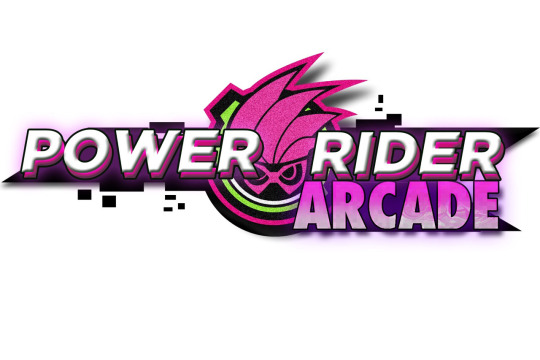
(Logo by Markolios and @riceyhot)
Years ago a team of programmers working for Magnus Games attempted to create the world’s greatest video game. It would be called EX-AID (Electric Xenosis- Adventure in Datatropolis). Part of what would make it so unique was that the game would learn and adapt to the player meaning no two playthroughs would be the same. Enemies would adapt to player techniques, the player’s characters would level up and adapt to the players style. Even the worlds would subtly adapt to the player. This system was called V.A.I (Virtual Artificial Intelligence)
The plot was that in the world of data and code existed a land called Datatropolis. The various worlds lived in peace with one another until the evil VAI attacked with his viral minions. A call went out from the capital city for help. A group of Heroes answered the call.
From the Hall of Heroes came Vic, the greatest of heroes (Action/Platformer)- “Let’s play a game! *item collection noise*” From the Kingdom of Fantasy came Sir Valor, the noblest of knights (RPG)- “Let us go forth into battle! *swords clash*” From the War Zone came Sargent Sniper, expert with all firearms (Shooting)- “Lock and load! *gun loads*” From the racetrack of Velo City came Speedstar the fastest racer. (Racing)- “Race ya! *car speeds off*” From the Sport Stadium came Athy Lete master of all sports (Sports)- “Let’s make it sporting! *crowd cheers*” From the Institute of Intelligence came Eyeque, the host of the Premium Puzzle game show (Puzzle)- “Have I got a puzzle for you! *game show buzzer*” From the Combat Arena came Champ, the strongest of fighters. (Fighting)- “Step into the ring! *bell rings*” From Terror Town came the Night Mayor, ruler of horrors. (Horror)- “Behold the horrors of the night! *ghostly wail*” From the Harmony Concert Hall came Melody, the most popular pop star (Music/Rhythm/Dancing)- “Time for the big show! *musical scale*”
These Heroes would unite to fight VAI and his forces.
However before the game was completed the budget ran out and the project was canceled. Two of the programmers began to delete the data, however when they tried to delete V.A.I he managed to escape it. Before it vanished V.A.I vowed revenge for being thrown away like garbage. As it escaped V.A.I managed to steal the data of many of the Heroes
When the pair tried to warn the others they were laughed off. So the two transferred the data of the remaining Four Heroes to a new computer should the day come that V.A.I returned.
In the meantime the pair married and opened an arcade. Soon they had a son they named Elliot and the threat of V.A.I seemed so far away.
However one day V.A.I returned with a vengeance. Having gained the ability to create viruses monsters called Virugs he launched his attack. While fleeing the first attack Elliot and two other teens found a hidden base under the arcade containing the computer with the data of the Four Heroes on it.
The programmers revealed the truth behind EX-AID and V.A.I to the teens who volunteered to fight back. And so the teens and the Heroes united to become Power Rider Arcade.
The Heroes act as avatars for the teens, giving helpful hints similar to a tutorial. In battle the teens would head to a location where the Virug virus has emerged and using the Avatars of the Heroes fight a monster until it crossed over into the real world at which point they transform into the Riders to defeat it once more to destroy it.
At first Elliot and the others clash due to conflicting personalities but eventually they unite to fight the true threat.
They would face many dangers including a dark warrior called Glitch who used data from some of the fallen Heroes to fight the Riders. Glitch is soon joined by Coder an enigmatic warrior who serves V.A.I as well.
Shortly after the defeat of Glitch it is revealed that the CEO of Magnus Games, Stan Magnus was behind V.A.I’s rebellion. Stan believed he could use V.A.I to conquer the world and the only ones who stand in his way are the Arcade Riders.
Soon after this revelation V.A.I creates and mass produces cartridges that allows normal people to become Game Riders and Stan sells these through Magnus Games. However in reality V.A.I is merely using them to increase the power of the Virugs by having them use the Game Riders as practice. Furthermore the Game Riders are turned against the Arcade Riders by telling them they were enemies in the “game” and to make matters worse if a Game Rider is defeated they die for real.
Special monsters called Power Up Pals (P.U.P) merge with the Riders to unlock new forms. In game the P.U.P were friends and allies with the heroes.
Energy Items are formed when the Virug emerges into the real world and grant different abilities Speed High Jump Health Confusion Metal Giant Muscle Tiny Invisible Hint
Digital Dragon- In game this mighty beast was the ancient protector of the land however V.A.I’s attack left it weakened so it created Totems for the Heroes to use. The Totems would bestow them with armor and power. However when V.A.I escaped the Dragon was thought lost so the programmers saved the Totems just in case
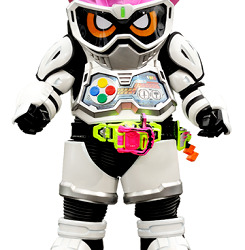
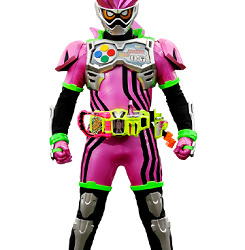
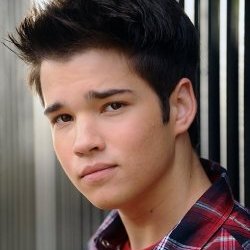
Arcade Player 1 “Warrior”-Vic Name: Elliot Booth
Age: 16
Personality/Bio: Elliot grew up in an arcade, as his parents were two of the original programmers working on Magnus Games' 'world's best video game', who eventually married and opened up an arcade. As a result of growing up in the arcade, he is a lifelong gamer. Perhaps because of his parents' dedication to deleting the data of the failed video game and stopping the spread of V.A.I., he is the Rider most dedicated to defeating V.A.I. when it's apparent that V.A.I. has returned for revenge. During V.A.I.'s first attack, Elliot and the other Riders discovered a hidden base underneath the arcade. His parents explained everything to them and they agreed to take up the mantle as Power Rider Arcade. As Power Rider Warrior, his personal weapon is the Smasher Slasher. His Hero aid is Vic. Elliot soon gains several new forms to defeat increasing threats.
Face Claim: Nathan Kress Transformation Device: Player Belt Transformation Call: Let’s Ride Transformation: A field of binary code covers them forming the armor Finishing Moves- Rider Warrior Smash/Slash/Kick/Punch Vehicle: Speedstar

Powered Up Mode- After freeing a P.U.P named Punchbot, Elliot gains an armored form and a rocket fist Finishing Move- Rider Power Punch
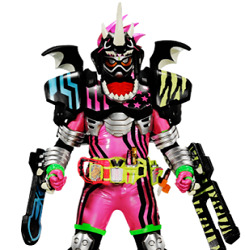
Digital Dragon Armor- Gains armor, sword, and blasters. Finishing Move- Rider Warrior Dragon Slash/Shot
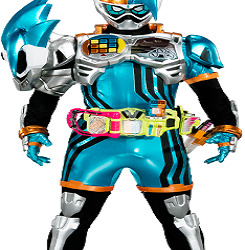

Super Mode- Multiplayer Mode- Vic and Elliot each control one Body in both Avatar and Rider mode. Rider mode splits into two, one controlled by Vic the other by Elliot.
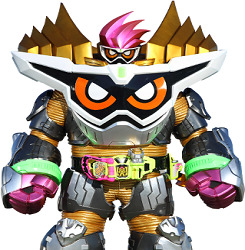

Final Mode- Victory Armor/Power - Two modes. Armor gains increased stats and Power grants temporary invincibility and the ability to permanently delete Virugs. Finishing Move- Rider Victory Kick/Punch
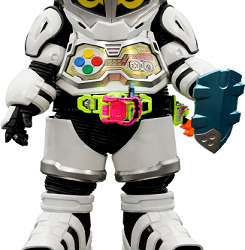
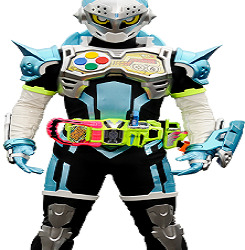

Arcade Player 2 “Knight”- Sir Valor Name: Harvey Ritter
Age: 16
Personality/Bio: Harvey is a bookworm and isn't afraid to let others know just how smart he is. He and Tara, Power Rider Soldier, don't get along due to a grudge between them, stemming from years ago. Harvey mostly keeps to himself, his nose always in a book, but Elliot, little by little, slowly brings him out of his more arrogant loner shell, making him a much better person later on. Eventually, due to the efforts of Elliot and Nicole, he and Tara resolve their grudge and patch things up. They don't quite become friends, but they recognize each other's strengths and weaknesses, both on and off the battlefield. His Hero aid is Sir Valor and his personal weapon, as Power Rider Knight, is the Sword of the Frozen Flame. Much like Elliot , he gains access to more powerful forms as the battles get tougher and tougher.
Face Claim: Kevin G. Schmidt Transformation Device: Player Belt Transformation Call: Let’s Ride Transformation: A field of binary code covers them forming the armor Finishing Move- Rider Knight Slash

Powered Up Mode- After freeing a P.U.P named DeeJay, Harvey gains sonic based attacks Finishing Move- Rider Power Sonic Blast

Digital Dragon Armor- Gains armor, sword, and blasters. Finishing Move- Rider Knight Dragon Slash/Shot
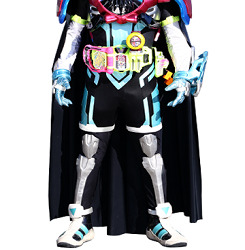
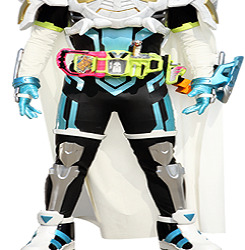
Super Mode- King Mode- Can summon an army of Virugs and channel great energy. At first King Mode is corrupted by the Virug virus however in time he manages to erase the virus leading to the True King Mode Finishing Move- Rider King Judgement
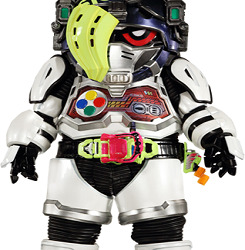
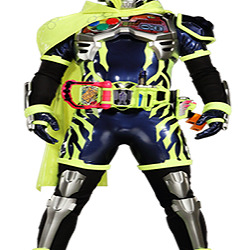

Arcade Player 3 “Soldier”- Sargent Sniper Name: Tara Katona
Age: 17
Personality/Bio: Tara is a girl living in the lap of luxury due to the wealth of her parents. Her parents spoil her and treat her like a princess, but in return, she hides her true self from them. Her true self is a tomboy who is quick to anger and who holds a long-standing grudge with Harvey. Eventually, she and Harvey reconcile and become more understanding of each other. She is a fierce protector of her friends, especially Nicole, whom she treats like her little sister. Her Hero aid is Sergeant Sniper and her personal weapon, as Power Rider Soldier, is the Sniper Pistol. As with Elliot and Harvey's powerups, Tara receives her own, allowing her to fight on par with them.
Face Claim: Nicola Peltz Transformation Device: Player Belt Transformation Call: Let’s Ride Transformation: A field of binary code covers them forming the armor Finishing Move- Rider Soldier Blast

Powered Up Mode- After freeing a P.U.P named TakeOff, Tara gains a jet pack and cannons. Finishing Move- Rider Power Blast
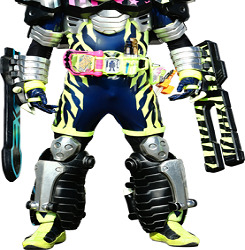
Digital Dragon Armor- Gains armor, sword, and blasters. Finishing Move- Rider Soldier Dragon Slash/Shot

Super Mode- Commander Mode- Gains a large amount of guns and blasters and can track and target any foe. Finishing Move- Rider Commander Artillery

Arcade Player 4 “Biker”- Speedstar- Kyle (later)- At first Speedstar fights alongside the teens by being uploaded into a bike however during a battle with Glitch Speedstar’s Rider form is damaged beyond repair and must remain in his bike mode.
Transformation Call: Let’s Ride Finishing Move- Rider Biker Rush

In his vehicle form Speedstar can reach incredible speeds in a short amount of time, however he lacks many of his attacks and cannot interact much.
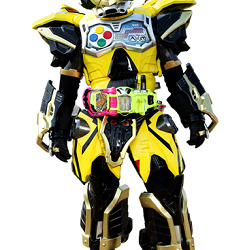
Powered Up Mode- After freeing a P.U.P named Sammy Rai, Speedstar gains a body to fight with Finishing Move- Rider Power Arrow
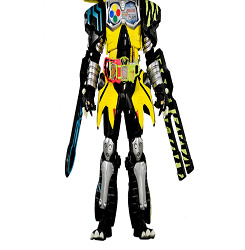
Digital Dragon Armor- Gains armor, sword, and blasters. Finishing Move- Rider Biker Dragon Slash/Shot
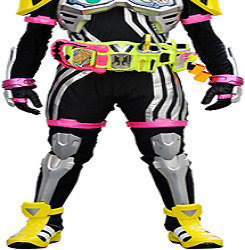

Name: Kyle Stevens
Age: 16
Personality/Bio: Kyle is a BMX biker and Elliot's best friend. They met on the first day of school and have been friends since. After his friend keeps disappearing, he decides to investigate. His investigation leads him to the Booth family arcade, where he discovers the hidden base of the Riders. Elliot makes Kyle promise to keep everything he's seen a secret, to which Kyle complies. Kyle eventually meets a newly repaired Speedstar, who asks him to fight alongside him as Power Rider Biker V2. At first, Kyle is a bit hesitant, not wanting to give up BMX biking in order to save the world, but Elliot manages to convince him that he can do both. Kyle finally accepts, knowing that if he wants to continue BMX biking, he must have a safe world to do it in.
Face Claim: Jaden Smith Transformation Device: Player Belt Transformation Call: Let’s Ride Transformation: A field of binary code covers them forming the armor Finishing Move: Rider Biker Rush

In this new form they are able to utilize Athy Lete’s data as Glitch once did Finishing Move- Rider Biker Discus
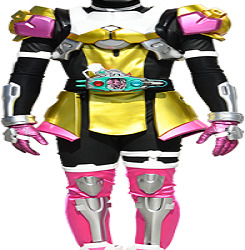

Arcade Player 5 “Dancer”- Melody Name: Ashley Sharp
Age: 17
Personality/Bio: Ashley is a cheerleader at the school Elliot and the others attend. As one of the popular girls, she tends to manipulate those around her into doing things for her, such as carrying her books to class and holding doors open for her. Due to her manipulation skills she is kidnapped by V.A.I. and brainwashed into fighting the Riders as Hacker. She is also used to distribute the Game Rider cartridges as part of V.A.I.'s bigger plan. She is eventually freed from her brainwashing through the great efforts of Elliot, to whom she feels a bit indebted for saving her. She joins the Riders as Power Rider Melody in order to fight against V.A.I. and prove that she's can become a much better person and prove V.A.I wrong.
Face Claim: Ashley Tisdale Transformation Device: Player Belt Transformation Call: Let’s Ride Transformation: A field of binary code covers them forming the armor Finishing Move- Rider Dancer Concert
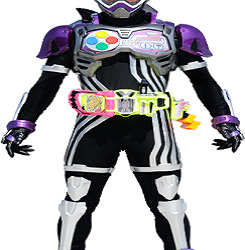
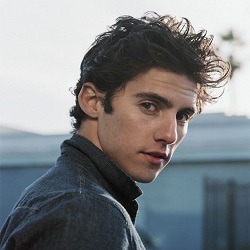
Arcade Player 6 “Secret”- Tory Name: Drake Magnus
Age: 25
Personality/Bio: Drake is the son of Stan Magnus, CEO of Magnus Games. When he discovered the truth about his father and V.A.I, he stole a Rider Cartridge from him. This cartridge contained a hidden character, Tory, who is a palette swap of Vic. Tory allows Drake to transform into Power Rider Secret. Drake later uses reclaimed data from the Night Mayor game to upgrade his Rider form and can charge his attacks with dark energies.
Face Claim: Milo Ventimiglia Transformation Device: Player Belt Transformation Call: Let’s Ride Transformation: A field of binary code covers them forming the armor Finishing Move- Rider Secret Kick/Punch

When using the data of Night Mayor Drake can charge his attacks with dark powers. Finishing Move- Rider Secret Horde
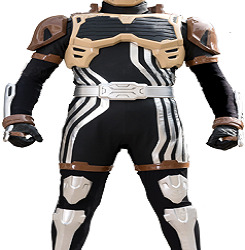

Name: Nicole Jimenez-Kalea
Age: 15
Rider Designation: Gamer Rider Personality: Headstrong, a little bratty, keeps cool under pressure, wary and shy around things that weird her out, unafraid to show her emotions, especially disgust or contempt
Bio: Nicole is a long time friend of Tara, and treats her like a big sister. She's a genius gamer and proud of it. Any time her winning streak is broken, she locks herself in a room for a few days and trains until she gets them back. But Nicole doesn't her idolization of "big sis" Tara stop her from bullying Tara into doing things like social interaction or beating up people that break her winning streaks. Nicole and Tara were practically glued at the hip since first grade, so when Tara started disappearing with Elliot and co more and more often, she followed them to figure out what they were doing with her "big sis." After learning the weird armored people running around town were Tara's friends, she promised to keep their secret, but she didn't keep her promise to stay out of danger. Nico follows them around on missions, cheering them on from the sidelines. She immediately buys a Gamer Rider cartridge when Magnus Games starts being distributing them. She proves her fighting prowess based on her gaming skills immediately and Tara grudgingly allows her to help out.
Face claim: Auli'i Cravalho
Transformation Device: Gamer Belt Transformation Call: Let’s Ride Transformation: A field of binary code covers them forming the armor Finishing Move- Game Rider Kick/Punch
V.A.I’s forces


Glitch- First warrior, as the battles continued V.A.I gave him data taken from Athy Lete and Night Mayor. Eventually destroyed and the data was retaken by the Riders.
Finishing Moves- Glitch Kick/Punch,
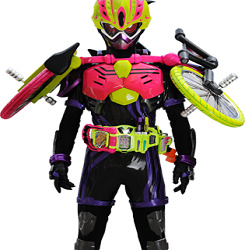
When using the data stolen from Athy Lete Glitch gains armor and throwing discuses Finishing Move- Glitch Sport Slasher

When using the data stolen from Night Mayor Glitch gains a new form and the ability to survive mortal blows. His attacks are charged with dark energy Finishing Move- Glitch Horror Assault
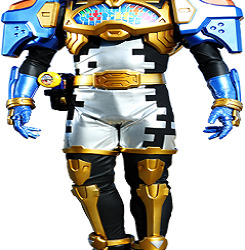
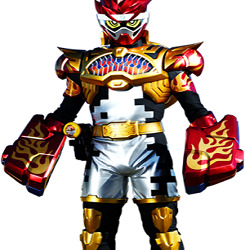
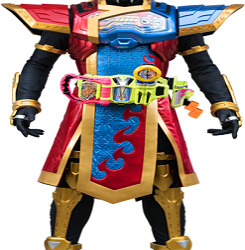

Coder- The second warrior created by V.A.I using the data from Eyeque and Champ. In Puzzle mode he can utilize energy items in unique combinations and in Fighter mode he gains fiery punches. He then gains the power to combine the two to form Combo mode.
Eventually he is betrayed by V.A.I and Magnus after outliving his usefulness. He is forced to defect to the Riders and his damage causes him to become an Avatar to assist Perry Peterson, a nerdy teacher from the school the teens attend.Perry then becomes Power Rider Scholar.
Name: Perry Peterson
Age: 30
Personality/Bio: Perry is a rather nerdy instructor at the school the Riders attend. After Coder is heavily damaged and betrayed, he defects to the Riders' side and becomes an avatar for Perry, who uses him to transform into Power Rider Scholar. As their teacher, and oldest of the heroic Riders, Perry watches over them both on and off the battlefield. He originally had no idea his students were the Riders until he received his powers and began fighting with them. His students discovered Power Rider Scholar's true identity after he finished fighting off a group of Virugs attacking a group of people. He de-transformed, but hadn't realized there were people watching him. After his students found out who he was, they were shocked, but Elliot invited him to fight with them, an invitation which Mr. Peterson accepted. If anyone asks what the group is doing, when they go off to fight Virugs and V.A.I.'s forces, Mr. Peterson says they're going to a Gamer's Club meeting, being held at the Booth family arcade.
Face Claim: Ben Savage Transformation Device: Player Belt Transformation Call- Let’s Ride Transformation: A field of binary code covers them forming the armor Finishing Moves- Coder/Scholar Quiz/Knockout
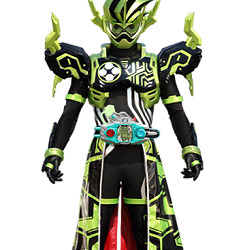
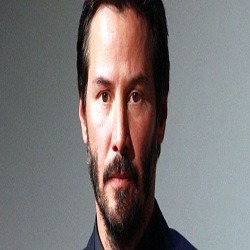
Mal Name: Stanley "Stan" Magnus
Age: 45
Personality/Bio: Stan began the war with V.A.I. when he helped the virus escape, intending to use it for world conquest. He was promised power and conquest by V.A.I., but is eventually betrayed after he outlives his usefulness. Stan becomes Mal and outfits his form with cheat codes in order to gain an advantage against the Arcade Riders. His advantage is erased, however, by the arrival of Elliot's Victory Power form. Stan is overtaken by V.A.I. after his betrayal, giving V.A.I. a physical body with which to personally fight the Arcade Riders. Stan is the CEO of Magnus Games and the father of Drake Magnus.
Face Claim: Keanu Reeves Transformation Device: Player Belt Transformation Call- Let’s Ride Transformation: A field of binary code covers them forming the armor Finishing Moves- Mal Crash
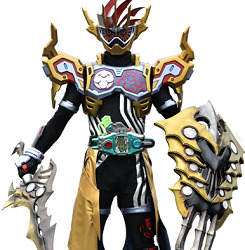
V.A.I- Virtual Artificial Intelligence- The virtual enemy that started it all. He was programmed to adapt and learn with each battle with the player, making each play though that much harder. However they programmed him too well and he gained sentience. He influenced Stan with promises of power and conquest only to betray him when he outlived his usefulness. V.A.I then took possession of his body to fight the Riders personally.

V.A.I- After his “rider” form is defeated he absorbs a large number of Virugs to mutate into his true boss form. This form is able to further mutate into a large monstrous form.
Power Rider Phantom/Arcade: The ghost of a video game programmer emerges across the internet and it’s up to the combined forces of the Phantom Rider and the Arcade Riders to exorcise the internet.
(Bios by @rosegrl18 and @highkickin-cylon)
Previous Powerverse Next
4 notes
·
View notes
Text
Anyone want to hear me ramble about a super old sonic oc I used to have just because I randomly remembered she existed and if I dont say something about her I’ll combust?
No?
WELL TO BAD:
This is the story of a not-so-very-really-I think-mary sue; Kira the hedgehog. (that I’ll try to remember with the best of my ability):
So, sadly I don’t have the drawings of her anymore but Kira was a blue-ish green hedgehog who, wait for it,,,
Was a Shadow-like experiment by Doctor Eggman! ‘cause it definetly heven’t been done before with hundred of other sonic ocs at the time hah. But something went wrong during her creation and ended up as a baby. Eggman, not wanting to get rid of a baby, decided to keep it in hopes it would grow up into a powerful minion.
He gets attached to baby Kira and raised her as his own daughter for a while, but then during a battle with sonic he realises is too dangerous to take care of a literal bby with sonic around. So he does the right thing by putting her in an orphanage in hopes of come back to her later on in the future (or at least thats what I think, dunno if younger me thought the same).
But she ends up being adopted by a new family, making her forget completly about Eggman.
Years pass with nothing much happening.
Until one day, Kira (now 11-13 I think) is going for a walk with her older step-brother when she finds a chaos emerald.
And CoNvInIeNtLy also, Eggman is there with some robots trying to find the chaos emerald.
He sees Kira and her brother with the emerald and surround them, but he can’t shake the feeling that girl hedgehog looks familiar...
But then GOOD OLD SONIC™ AND FRIENDS COME OUT OF NOWHERE AND DEFEACTS EGGMAN before he can do damage.
He goes to Kira and explain Eggman is evil blah blah chaos emerald go brrr blah blah. But the thing is, sonic noticed that Kira also helped attack Eggman with very similar powers than his own and that it was convenien she.managed to find it without a tracker.
So Kira becomes friends with the sonic crew and is now part of their group, yay!.
Lots of unrelated stuff happends and her and Tails are both crushing on eachother. But oh no Knuckles also likes her oh no...nO THE UNNECESSARY LOVE TRIANGLE!!.
More stuff happens like:
-Rouge being a jerk to Kira (for no reason apparently).
-Amy falling in love with Kira’s brother (for some reason, althou just to point it out, he looked a lot like Sonic...).
- Kira x Tails content.
-Kira training with Sonic to be better at battling with Eggman, I think.
-And finding chaos emeralds! (because what else you do in a Sonic fanfiction?).
At one point they do find all the emeralds but I don’t remember if they needed them for something or just wanted to keep them away from Eggman, knowing young me, probably neither.
Finally they rest at the pool/beach with Tails having all the emeralds in a bag (instead of keeping them at his plane? or somewhere safe??).
Rouge, being a binch for no reason (srry to all the Rouge the Bat fans out there who have to watch young me interpretation of her idk what I was thinking), decided it would be a fun idea to take the bag of chaos emeralds from Tails and throw them into the pool/ocean. And Kira was like:
“Hey, that was mean!”
And Rouge was like
“Then go get ‘em lol”
So Rouge punched her into the pool/ocean i guess. She swims to the emeralds and they start to glow.
Now, at this point you would think she is gonna transform into a super form like Sonic or Shadow.
But no, instead she transform into...
A FCKING MERMAID!
And after she transfrom the emeralds flew away (like the do).
And that’s as far as the story goes, hope you liked this whole mess!.
#my stuff#long post#this is so out there im sorry#I just like it when people share info of very old ocs of theirs#I wanna bring her back just for the laughts#but i dont think everyone would handle it lol#rambles
8 notes
·
View notes
Note
Why do you dislike Rosalina? Is it because of how she appears more often? If so, she has been a spin-off regular for quite some time now. I do think it was a bit odd for her to get into Smash and in a platformer before Daisy, but I like the character regardless. She is a unique and gorgeous addition to the cast. Before you ask, I adore all three of the Mario ladies equally!
Well, thankfully, I already had something typed up specifically for this occasion. It was going to be its own post, but I think an ask is a perfect segue into releasing this thing I’ve had lying around wondering whether I should post.
Now, DISCLAIMER: I’m not trying to tell anyone they shouldn’t like Rosalina. This is just the reason why I personally dislike the character. This is an opinion piece. Nothing more.
Also spoiler: I do dwell on her game appearances for a while, but that’s not the only thing I touch on.
If any of you read all that’s ahead, thank you so much for taking the time to hear me out and please excuse any pettiness I may display. Thank you.
Now, welcome to a rant I like to call…
DEATH BY OVER-HYPE: THE RISE AND FALL OF ROSALINA
Now, as we all know, Rosalina first appeared in 2007’s Super Mario Galaxy. In said game, she served as Mario’s guide, being the caretaker of the game’s spaceship hub world, the Comet Observatory, and its residents, the Lumas. She was regal, mysterious, and motherly with a stoic yet kind air to her. You really got the sense that she was unlike any character in the series beforehand. She was powerful and she was in a league of her own.
This same game also gave us Rosalina’s backstory in the form of her storybook. She was just a normal girl until she found a Luma and a broken spaceship. She helped the Luma repair the spaceship and set off into space with it to find its lost mother. Along the way, she took in more Lumas, who became her family as she traveled through space. There’s something about a dead mother in there that I thought was way better explained than it actually was and then the first Luma Rosalina met transformed into the Comet that became the Comet Observatory. It’s a touching story.
After that, Rosalina began appearing rather frequently. Of course, she regularly showed up in Mario Kart starting just a year after her debut, but she also stepped foot into Mario Party, Mario Golf, Mario Tennis, Mario Sports Superstars, the Mario and Sonic series, and even bit cameos like the Mario Mash-Up pack for Minecraft or as a sprite in the moon-themed areas of Super Mario Odyssey. I have no complaint about any of these appearances. They’re all either inevitable and open to all sorts of characters already or, in the case of Super Mario Odyssey, it fits her role.
Now allow me to complain about a select few appearances that really get on my nerves.
Now, games like Mario Kart and Mario Party and all that make sense. Those are games where all sorts of characters show up and it makes sense for the most distinct characters to make constant appearances. Rosalina was always going to be a regular for those.
What I can’t excuse is three very specific games.
The first is Puzzles and Dragons: Super Mario Bros. Edition. Now, this might seem like a really weird game to be bringing up, but, when you really think about it, it’s really messed-up that Rosalina appears in this game. The only other non-enemy characters playable in this game are Mario, Luigi, Toad, Yoshi, and Peach. Rosalina has absolutely no reason to be in this game, yet here she is.
You know what other game Rosalina has absolutely no reason to be in? Super Mario 3D World.
Super Mario 3D World was Rosalina’s fifth appearance in the franchise and her very first playable appearance…in a game that takes place in another world, the Sprixie Kingdom, and whose only playable characters are franchise staples Mario, Luigi, Peach, and Toad in a throwback to the US version of Super Mario Bros 2. Rosalina has zero reason to be in this game, much less be a prominent playable character.
Then, there’s the biggest blow of them all, which came just one year after 3D World: Super Smash Bros.
If Rosalina hadn’t appeared in Super Mario 3D World, there would be absolutely zero merit to putting her in Smash Bros considering that, outside that single instance, she was made no more important than any other character in the Mario series and she had never done anything to merit a Smash appearance. Because Super Mario 3D World exists, though, she has to appear in Smash, right?
And then there’s a point that I’ve had yet to bring up: the existence of Baby Rosalina. Like, gee. Rosalina sure warrants a baby form that goes against her entire backstory, doesn’t she? Let’s just do that.
By now, my biggest problem with Rosalina should be readily apparent. Rosalina shot to favorite child status way too quickly and her most egregious appearances are nothing more than blatant fanservice.
There’s an old document I have where I try to talk about my distaste for Rosalina. The explanation was really poorly thought out and filled with a lot of salt that didn’t need to be there, but one particular section I can still get behind is one where I essentially compare Rosalina to Shadow the Hedgehog. I think the comparison is still rather relevant.
Once you really start thinking about it, Rosalina really has this kind of Shadow the Hedgehog syndrome, not in the personality itself, but in how her creators treat her. Both characters were created for a specific purpose in a specific game in already well-established franchises with a lot of characters already, but gained an explosion of popularity due to popular aspects in their characters along with their compelling backstories that shot them past the other characters into a place where they’re now used in just about every game including ones they have no place in and are touted by their fandoms as some of the best characters to ever exist.
One major difference between Shadow and Rosalina, though, is that Shadow is actually a really well-developed character that has developed even beyond where he first came from. This is the effect of being part of a largely story-driven franchise that has allowed Shadow to evolve and come into his own. He’s earned his place among the cast through meaningful interaction.
Rosalina is cursed with coming from a franchise that doesn’t even have well-established characters much less any kind of evolving story. Rosalina just…exists, meaning she can’t do anything to really make herself fit in being who she is. Her personality constantly fluctuates to the point where the most I can tell you about her personality is that “she’s nice”. The rest of the main characters in the franchise all come from the same world and regularly interact with each other. This has the negative effect of making Rosalina feel like an outsider. She doesn’t need to be there in any instance and any time she is it just feels like going out of her way to be there, which would be fine if Nintendo wasn’t trying to sell her as this mature, introverted character that’s supposed to contrast the rest of the cast. She’s constantly contradicting herself left and right and it doesn’t feel like Nintendo ever really knows what to do with her but shove her in everywhere they can because “she’s popular, right?”.
That would be the reason I don’t like Rosalina. She doesn’t fit in, but Nintendo keeps trying to shove her where she doesn’t belong. She doesn’t have a consistent identity outside of the one from Galaxy that she keeps contradicting all the time and she’s been in games she has absolutely no business being in for absolutely no justifiable reason.
Now, maybe I’m just being over-critical, but this is something I personally feel very strongly about. Rosalina is one of the most overrated characters in existence in my opinion and it’s gotten to the point where I don’t even want to see her anymore, even in places that she does belong. She’s been absolutely ruined for me by Nintendo’s practices concerning the Mario franchise and I can’t even stand her anymore.
Yes, it’s petty, but that’s just me.
At the end of the day, I know that this is just my opinion. I hope no one came to this rant expecting otherwise. I just wanted to make clear my emotions about this character. If you’ve made it to this point, thank you for hearing me out. Have a nice day.
(oh this is going to be sooooooo controversiallllll….)
2 notes
·
View notes
Text
What If 4Kids Entertainment Never Dubbed “One Piece?”

4Kids Entertainment was probably the worst dubbing company to ever exist. One Piece was their worst work, because of so many edits like cigarettes as suckers, real guns as water guns, and throwing darts as plunger-things; the bad voice acting; the terrible soundtrack; and the entire plot changes. Not that I am a big fan of One Piece myself, but the dub completely ruined it. Well, at least Funimation fixed this.
4Kids dubbed other shows like Pokémon (Pocket Monsters), the Yu-Gi-Oh saga, Sonic X, Mew Mew Power (Tokyo Mew Mew), Fighting Foodons, Ultimate Muscle, Dinosaur King, Shamen King, and maybe GaoGaiGar. But many of them are so terrible that the originals are better and a little more mature.
I saw Sonic X in its original language with English subtitles, and I really liked it. But, when I compared some episodes with the English dubbed version, the dub was just awful; although the voice acting wasn’t so bad, especially in the games (particularly Shadow’s game).
Anyway, 4Kids’ One Piece was notorious for these censorship and editing, and may have contributed to 4Kids going bankrupt. I believe that 4Kids had so much potential to be redeemed, but the show did not help them succeed.
And then I thought, “What if they never dubbed One Piece and dubbed some other show that may or may not heighten their career, and delay their career decline?” That was when I came across anime shows that I know were awful in their dubs; and the first thing I saw was Transformers Armada (or originally, Super Robot Lifeform Transformer: Legend Of The Microns; or Micron Legend for short), among other shows of the Unicron Trilogy. The dubs were to be broadcasted first, and this resulted in rushed production, really bad dubbing, nonsensical plot points, and awful animation. And this thought came to mind:
“Hey, since One Piece was redubbed by Funimation and was better than the 4Kids dub as a result, how about 4Kids redub the whole Unicron Trilogy using Micron Legend, Superlink, and Galaxy Force, as well as some parts of Armada, Energon, and Cybertron if it means making the shows ‘family-friendly’ to American viewers? It may not be good, in fact it may still be worse than the original anime, but at least it would be better than the One Piece dub. What if it becomes a surprise hit and surpasses Ultimate Muscle, or it is just as dark as Shamen King? And what if Optimus Prime sings the National Anthem instead of Luffy? That would be nice.”
That being said, however, there are plenty of other shows that would be better or worse (but better than One Piece) if dubbed or redubbed by 4Kids. I have a poll on DeviantArt about just that.
Reblog to give off other suggestions for anime that needed dubbing/redubbing.
If you think 4Kids would have failed anyway, even with my suggestion, that is fine; I will not judge.
#4kids#4kids entertainment#4kids is garbage#one piece#one piece is ruined thanks to 4kids#damn you 4kids#4kids ruined one piece#what if 4kids dubbed other shows?#do you think the transformers unicron trilogy needed redubbing?#censorship and edits#why 4kids? why?#it had potential#redub#funimation#one piece anime#ideas for a redub#if they could start all over#dub
5 notes
·
View notes
Text
Power Rider Arcade
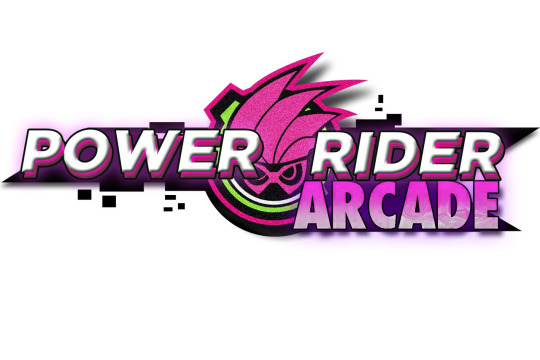
(Logo by Markolios and @riceyhot)
Years ago a team of programmers working for Magnus Games attempted to create the world’s greatest video game. It would be called EX-AID (Electric Xenosis- Adventure in Datatropolis). Part of what would make it so unique was that the game would learn and adapt to the player meaning no two playthroughs would be the same. Enemies would adapt to player techniques, the player’s characters would level up and adapt to the players style. Even the worlds would subtly adapt to the player. This system was called V.A.I (Virtual Artificial Intelligence) The plot was that in the world of data and code existed a land called Datatropolis. The various worlds lived in peace with one another until the evil VAI attacked with his viral minions. A call went out from the capital city for help. A group of Heroes answered the call. From the Hall of Heroes came Vic, the greatest of heroes (Action/Platformer)- “Let’s play a game! *Item collection noise*” From the Kingdom of Fantasy came Sir Valor, the noblest of knights (RPG)- “Let us go forth into battle! *Swords clash*” From the War Zone came Sargent Sniper, expert with all firearms (Shooting)- “Lock and load! *Gun loads*” From the racetrack of Velo City came Speedstar the fastest racer. (Racing)- “Race ya! *Car speeds off*” From the Sport Stadium came Athy Lete master of all sports (Sports)- “Let’s make it sporting! *Crowd cheers*” From the Institute of Intelligence came Eyeque, the host of the Premium Puzzle game show (Puzzle)- “Have I got a puzzle for you! *Game show buzzer* From the Combat Arena came Champ, the strongest of fighters. (Fighting)- “Step into the ring! *Bell rings*” From Terror Town came the Night Mayor, ruler of horrors. (Horror)- “Behold the horrors of the night! *Ghostly wail*” From the Harmony Concert Hall came Melody, the most popular pop star (Music/Rhythm/Dancing)- “Time for the big show! *Musical scale*” These Heroes would unite to fight VAI and his forces. However before the game was completed the budget ran out and the project was canceled. Two of the programmers began to delete the data, however when they tried to delete V.A.I he managed to escape it. Before it vanished V.A.I vowed revenge for being thrown away like garbage. As it escaped V.A.I managed to steal the data of many of the Heroes When the pair tried to warn the others they were laughed off. So the two transferred the data of the remaining Four Heroes to a new computer should the day come that V.A.I returned. In the meantime the pair married and opened an arcade. Soon they had a son they named Elliot and the threat of V.A.I seemed so far away. However one day V.A.I returned with a vengeance. Having gained the ability to create viruses monsters called Virugs he launched his attack. While fleeing the first attack Elliot and two other teens found a hidden base under the arcade containing the computer with the data of the Four Heroes on it. The programmers revealed the truth behind EX-AID and V.A.I to the teens who volunteered to fight back. And so the teens and the Heroes united to become Power Rider Arcade. The Heroes act as avatars for the teens, giving helpful hints similar to a tutorial. In battle the teens would head to a location where the Virug virus has emerged and using the Avatars of the Heroes fight a monster until it crossed over into the real world at which point they transform into the Riders to defeat it once more to destroy it. At first Elliot and the others clash due to conflicting personalities but eventually they unite to fight the true threat. They would face many dangers including a dark warrior called Glitch who used data from some of the fallen Heroes to fight the Riders. Glitch is soon joined by Coder an enigmatic warrior who serves V.A.I as well. Shortly after the defeat of Glitch it is revealed that the CEO of Magnus Games, Stan Magnus was behind V.A.I’s rebellion. Stan believed he could use V.A.I to conquer the world and the only ones who stand in his way are the Arcade Riders. Soon after this revelation V.A.I creates and mass produces cartridges that allows normal people to become Game Riders and Stan sells these through Magnus Games. However in reality V.A.I is merely using them to increase the power of the Virugs by having them use the Game Riders as practice. Furthermore the Game Riders are turned against the Arcade Riders by telling them they were enemies in the “game” and to make matters worse if a Game Rider is defeated they die for real. Special monsters called Power Up Pals (P.U.P) merge with the Riders to unlock new forms. In game the P.U.P were friends and allies with the heroes. Energy Items are formed when the Virug emerges into the real world and grant different abilities Speed High Jump Health Confusion Metal Giant Muscle Tiny Invisible Hint Digital Dragon- In game this mighty beast was the ancient protector of the land however V.A.I’s attack left it weakened so it created Totems for the Heroes to use. The Totems would bestow them with armor and power. However when V.A.I escaped the Dragon was thought lost so the programmers saved the Totems just in case
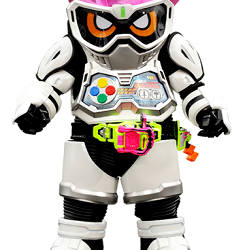
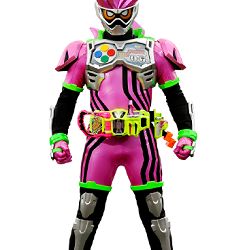
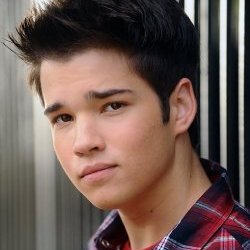
Arcade Player 1 “Warrior”-Vic Name: Elliot Booth Age: 16 Personality/Bio: Elliot grew up in an arcade, as his parents were two of the original programmers working on Magnus Games’ ‘world’s best video game’, who eventually married and opened up an arcade. As a result of growing up in the arcade, he is a lifelong gamer. Perhaps because of his parents’ dedication to deleting the data of the failed video game and stopping the spread of V.A.I., he is the Rider most dedicated to defeating V.A.I. when it’s apparent that V.A.I. has returned for revenge. During V.A.I.’s first attack, Elliot and the other Riders discovered a hidden base underneath the arcade. His parents explained everything to them and they agreed to take up the mantle as Power Rider Arcade. As Power Rider Warrior, his personal weapon is the Smasher Slasher. His Hero aid is Vic. Elliot soon gains several new forms to defeat increasing threats. Face Claim: Nathan Kress Transformation Device: Player Belt Transformation Call: Let’s Ride Transformation: A field of binary code covers them forming the armor Finishing Moves- Rider Warrior Smash/Slash/Kick/Punch Vehicle: Speedstar

Powered Up Mode- After freeing a P.U.P named Punchbot, Elliot gains an armored form and a rocket fist Finishing Move- Rider Power Punch
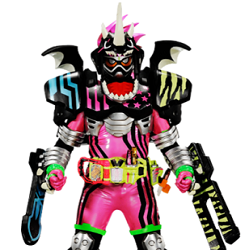
Digital Dragon Armor- Gains armor, sword, and blasters. Finishing Move- Rider Warrior Dragon Slash/Shot

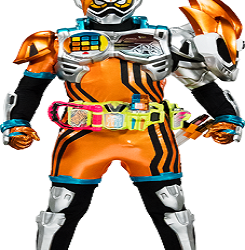
Super Mode- Multiplayer Mode- Vic and Elliot each control one Body in both Avatar and Rider mode. Rider mode splits into two, one controlled by Vic the other by Elliot.
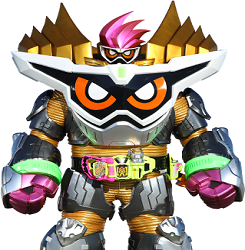
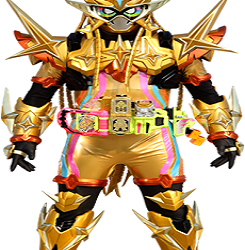
Final Mode- Victory Armor/Power - Two modes. Armor gains increased stats and Power grants temporary invincibility and the ability to permanently delete Virugs. Finishing Move- Rider Victory Kick/Punch



Arcade Player 2 “Knight”- Sir Valor Name: Harvey Ritter Age: 16 Personality/Bio: Harvey is a bookworm and isn’t afraid to let others know just how smart he is. He and Tara, Power Rider Soldier, don’t get along due to a grudge between them, stemming from years ago. Harvey mostly keeps to himself, his nose always in a book, but Elliot, little by little, slowly brings him out of his more arrogant loner shell, making him a much better person later on. Eventually, due to the efforts of Elliot and Nicole, he and Tara resolve their grudge and patch things up. They don’t quite become friends, but they recognize each other’s strengths and weaknesses, both on and off the battlefield. His Hero aid is Sir Valor and his personal weapon, as Power Rider Knight, is the Sword of the Frozen Flame. Much like Elliot , he gains access to more powerful forms as the battles get tougher and tougher. Face Claim: Kevin G. Schmidt Transformation Device: Player Belt Transformation Call: Let’s Ride Transformation: A field of binary code covers them forming the armor Finishing Move- Rider Knight Slash

Powered Up Mode- After freeing a P.U.P named DeeJay, Harvey gains sonic based attacks Finishing Move- Rider Power Sonic Blast

Digital Dragon Armor- Gains armor, sword, and blasters. Finishing Move- Rider Knight Dragon Slash/Shot
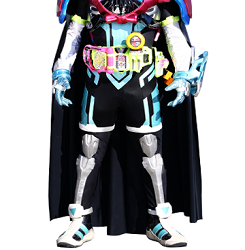
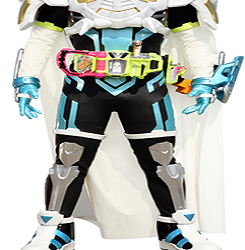
Super Mode- King Mode- Can summon an army of Virugs and channel great energy. At first King Mode is corrupted by the Virug virus however in time he manages to erase the virus leading to the True King Mode Finishing Move- Rider King Judgement
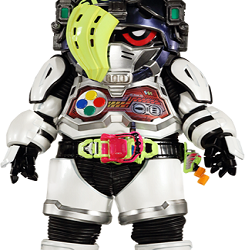


Arcade Player 3 “Soldier”- Sargent Sniper Name: Tara Katona Age: 17 Personality/Bio: Tara is a girl living in the lap of luxury due to the wealth of her parents. Her parents spoil her and treat her like a princess, but in return, she hides her true self from them. Her true self is a tomboy who is quick to anger and who holds a long-standing grudge with Harvey. Eventually, she and Harvey reconcile and become more understanding of each other. She is a fierce protector of her friends, especially Nicole, whom she treats like her little sister. Her Hero aid is Sergeant Sniper and her personal weapon, as Power Rider Soldier, is the Sniper Pistol. As with Elliot and Harvey’s powerups, Tara receives her own, allowing her to fight on par with them. Face Claim: Nicola Peltz Transformation Device: Player Belt Transformation Call: Let’s Ride Transformation: A field of binary code covers them forming the armor Finishing Move- Rider Soldier Blast
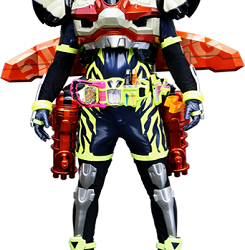
Powered Up Mode- After freeing a P.U.P named TakeOff, Tara gains a jet pack and cannons. Finishing Move- Rider Power Blast
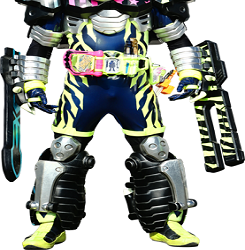
Digital Dragon Armor- Gains armor, sword, and blasters. Finishing Move- Rider Soldier Dragon Slash/Shot
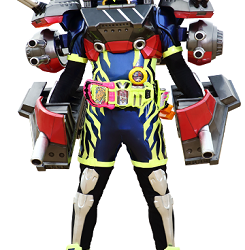
Super Mode- Commander Mode- Gains a large amount of guns and blasters and can track and target any foe. Finishing Move- Rider Commander Artillery
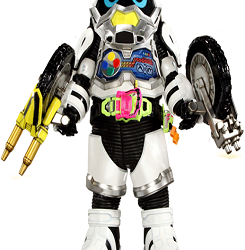
Arcade Player 4 “Biker”- Speedstar- Kyle (later)- At first Speedstar fights alongside the teens by being uploaded into a bike however during a battle with Glitch Speedstar’s Rider form is damaged beyond repair and must remain in his bike mode. Transformation Call: Let’s Ride Finishing Move- Rider Biker Rush

In his vehicle form Speedstar can reach incredible speeds in a short amount of time, however he lacks many of his attacks and cannot interact much.
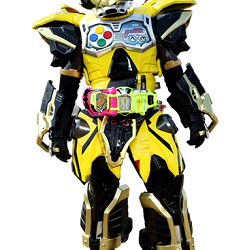
Powered Up Mode- After freeing a P.U.P named Sammy Rai, Speedstar gains a body to fight with Finishing Move- Rider Power Arrow
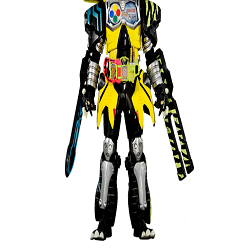
Digital Dragon Armor- Gains armor, sword, and blasters. Finishing Move- Rider Biker Dragon Slash/Shot
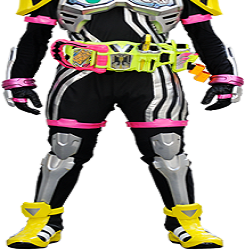

Name: Kyle Stevens Age: 16 Personality/Bio: Kyle is a BMX biker and Elliot’s best friend. They met on the first day of school and have been friends since. After his friend keeps disappearing, he decides to investigate. His investigation leads him to the Booth family arcade, where he discovers the hidden base of the Riders. Elliot makes Kyle promise to keep everything he’s seen a secret, to which Kyle complies. Kyle eventually meets a newly repaired Speedstar, who asks him to fight alongside him as Power Rider Biker V2. At first, Kyle is a bit hesitant, not wanting to give up BMX biking in order to save the world, but Elliot manages to convince him that he can do both. Kyle finally accepts, knowing that if he wants to continue BMX biking, he must have a safe world to do it in. Face Claim: Jaden Smith Transformation Device: Player Belt Transformation Call: Let’s Ride Transformation: A field of binary code covers them forming the armor Finishing Move: Rider Biker Rush
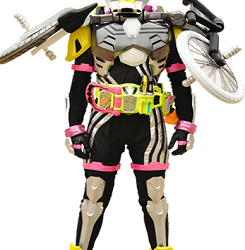
In this new form they are able to utilize Athy Lete’s data as Glitch once did Finishing Move- Rider Biker Discus
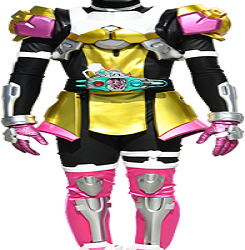

Arcade Player 5 “Dancer”- Melody Name: Ashley Sharp Age: 17 Personality/Bio: Ashley is a cheerleader at the school Elliot and the others attend. As one of the popular girls, she tends to manipulate those around her into doing things for her, such as carrying her books to class and holding doors open for her. Due to her manipulation skills she is kidnapped by V.A.I. and brainwashed into fighting the Riders as Hacker. She is also used to distribute the Game Rider cartridges as part of V.A.I.’s bigger plan. She is eventually freed from her brainwashing through the great efforts of Elliot, to whom she feels a bit indebted for saving her. She joins the Riders as Power Rider Melody in order to fight against V.A.I. and prove that she’s can become a much better person and prove V.A.I wrong. Face Claim: Ashley Tisdale Transformation Device: Player Belt Transformation Call: Let’s Ride Transformation: A field of binary code covers them forming the armor Finishing Move- Rider Dancer Concert

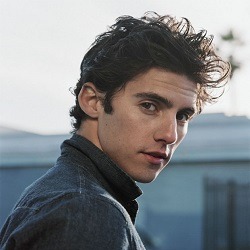
Arcade Player 6 “Secret”- Tory Name: Drake Magnus Age: 25 Personality/Bio: Drake is the son of Stan Magnus, CEO of Magnus Games. When he discovered the truth about his father and V.A.I, he stole a Rider Cartridge from him. This cartridge contained a hidden character, Tory, who is a palette swap of Vic. Tory allows Drake to transform into Power Rider Secret. Drake later uses reclaimed data from the Night Mayor game to upgrade his Rider form and can charge his attacks with dark energies. Face Claim: Milo Ventimiglia Transformation Device: Player Belt Transformation Call: Let’s Ride Transformation: A field of binary code covers them forming the armor Finishing Move- Rider Secret Kick/Punch
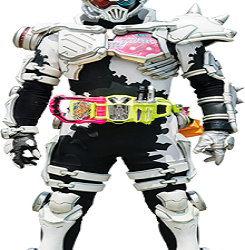
When using the data of Night Mayor Drake can charge his attacks with dark powers. Finishing Move- Rider Secret Horde
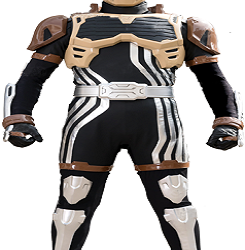

Name: Nicole Jimenez-Kalea Age: 15 Rider Designation: Gamer Rider Personality: Headstrong, a little bratty, keeps cool under pressure, wary and shy around things that weird her out, unafraid to show her emotions, especially disgust or contempt Bio: Nicole is a long time friend of Tara, and treats her like a big sister. She’s a genius gamer and proud of it. Any time her winning streak is broken, she locks herself in a room for a few days and trains until she gets them back. But Nicole doesn’t her idolization of “big sis” Tara stop her from bullying Tara into doing things like social interaction or beating up people that break her winning streaks. Nicole and Tara were practically glued at the hip since first grade, so when Tara started disappearing with Elliot and co more and more often, she followed them to figure out what they were doing with her “big sis.” After learning the weird armored people running around town were Tara’s friends, she promised to keep their secret, but she didn’t keep her promise to stay out of danger. Nico follows them around on missions, cheering them on from the sidelines. She immediately buys a Gamer Rider cartridge when Magnus Games starts being distributing them. She proves her fighting prowess based on her gaming skills immediately and Tara grudgingly allows her to help out. Face claim: Auli'i Cravalho Transformation Device: Gamer Belt Transformation Call: Let’s Ride Transformation: A field of binary code covers them forming the armor Finishing Move- Game Rider Kick/Punch V.A.I’s forces
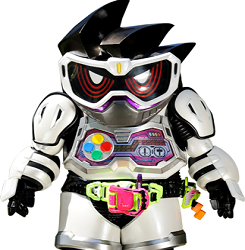
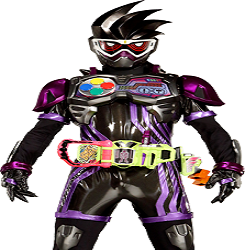
Glitch- First warrior, as the battles continued V.A.I gave him data taken from Athy Lete and Night Mayor. Eventually destroyed and the data was retaken by the Riders. Finishing Moves- Glitch Kick/Punch,

When using the data stolen from Athy Lete Glitch gains armor and throwing discuses Finishing Move- Glitch Sport Slasher
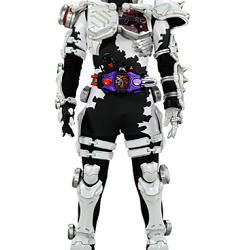
When using the data stolen from Night Mayor Glitch gains a new form and the ability to survive mortal blows. His attacks are charged with dark energy Finishing Move- Glitch Horror Assault
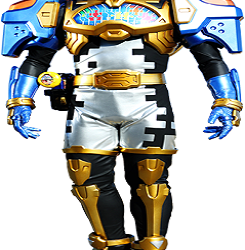
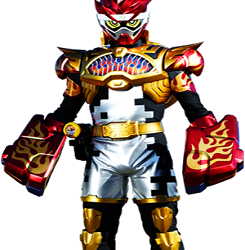
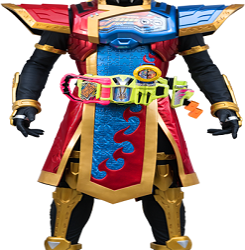

Coder- The second warrior created by V.A.I using the data from Eyeque and Champ. In Puzzle mode he can utilize energy items in unique combinations and in Fighter mode he gains fiery punches. He then gains the power to combine the two to form Combo mode. Eventually he is betrayed by V.A.I and Magnus after outliving his usefulness. He is forced to defect to the Riders and his damage causes him to become an Avatar to assist Perry Peterson, a nerdy teacher from the school the teens attend.Perry then becomes Power Rider Scholar. Name: Perry Peterson Age: 30 Personality/Bio: Perry is a rather nerdy instructor at the school the Riders attend. After Coder is heavily damaged and betrayed, he defects to the Riders’ side and becomes an avatar for Perry, who uses him to transform into Power Rider Scholar. As their teacher, and oldest of the heroic Riders, Perry watches over them both on and off the battlefield. He originally had no idea his students were the Riders until he received his powers and began fighting with them. His students discovered Power Rider Scholar’s true identity after he finished fighting off a group of Virugs attacking a group of people. He de-transformed, but hadn’t realized there were people watching him. After his students found out who he was, they were shocked, but Elliot invited him to fight with them, an invitation which Mr. Peterson accepted. If anyone asks what the group is doing, when they go off to fight Virugs and V.A.I.’s forces, Mr. Peterson says they’re going to a Gamer’s Club meeting, being held at the Booth family arcade. Face Claim: Ben Savage Transformation Device: Player Belt Transformation Call- Let’s Ride Transformation: A field of binary code covers them forming the armor Finishing Moves- Coder/Scholar Quiz/Knockout

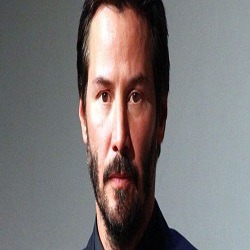
Mal Name: Stanley “Stan” Magnus Age: 45 Personality/Bio: Stan began the war with V.A.I. when he helped the virus escape, intending to use it for world conquest. He was promised power and conquest by V.A.I., but is eventually betrayed after he outlives his usefulness. Stan becomes Mal and outfits his form with cheat codes in order to gain an advantage against the Arcade Riders. His advantage is erased, however, by the arrival of Elliot’s Victory Power form. Stan is overtaken by V.A.I. after his betrayal, giving V.A.I. a physical body with which to personally fight the Arcade Riders. Stan is the CEO of Magnus Games and the father of Drake Magnus. Face Claim: Keanu Reeves Transformation Device: Player Belt Transformation Call- Let’s Ride Transformation: A field of binary code covers them forming the armor Finishing Moves- Mal Crash
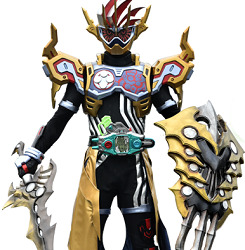
V.A.I- Virtual Artificial Intelligence- The virtual enemy that started it all. He was programmed to adapt and learn with each battle with the player, making each play though that much harder. However they programmed him too well and he gained sentience. He influenced Stan with promises of power and conquest only to betray him when he outlived his usefulness. V.A.I then took possession of his body to fight the Riders personally.
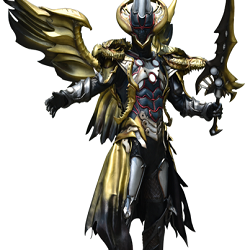
V.A.I- After his “rider” form is defeated he absorbs a large number of Virugs to mutate into his true boss form. This form is able to further mutate into a large monstrous form. Power Rider Phantom/Arcade: The ghost of a video game programmer emerges across the internet and it’s up to the combined forces of the Phantom Rider and the Arcade Riders to exorcise the internet. (Bios by @rosegrl18 and @highkickin-cylon) Previous Powerverse Next
1 note
·
View note
Text
Supes was my FAVE part of STC honestly!! He's such a cool plotline and its awesome that they even added a plotline at all to something that has barely anything to it in every other continuity. In STC super modes werent just a thing anyone can do when collecting all the chaos emeralds, it was some sort of fluke curse that hit sonic in particular the first time he collected them and he didnt even need them to transform again after that. But the side effect of unlimited access to super sonic is that it also comes with its own sort of sentience? Sonic couldnt transform at will, Super would just sorta come out whenever he wants, usually when sonic experiences extreme anger or trauma and it like..weakens his containment, i guess? The writers took the name chaos emeralds very seriously, in this universe theyre very dangerous as well as just powerful. Super Sonic was sort of the personification of this energy in living form, not necessarily literally evil but functionally so? Like he was just a completely wild lawless beast who did everything for the fun of chaos, with no concept of right or wrong. The only connection he had to those concepts was the darkness that existed in the heart of the person he was created from. so for example there was one time when they wrote Supes manifesting in a tough fight and indeed defeating the boss badnik, but then he doubled back and tried to attack the innocent animal he just freed from its power core, simply because all he knew was that sonic always worried about not hurting them when he fought, and he was tempted to see what it was like. (In this continuity 'roboticization' wasnt magically transforming flesh into metal but just cyborg stuff.) They did some VERY dark stuff with the concept of an empty hearted chaos creature whose only motivation was "fun" at any cost. And it worked so good as a contrast because regular sonic in these comics was a giant asshole who secretly had a good heart and was just grumpy AF. Contrasting him against this figure who was hyperacrive and funloving IN AN EVIL WAY SOMEHOW. What an amazing idea!!! And the whole concept of having a super move that has the side effect of potentially hurting the ones you love or even murdering innocent bystanders...WOW that had some good tension to it! And was a way better explanation for why sonic cant just use super sonic all the time, instead of just losing the chaos emeralds at the end of every game and having to collect them again.
Oh and they also did something EVEN COOLER with Supes later on!
THEY ACTUALLY TURNED HIM INTO A GOOD GUY
There was a point where some sort of magic mcguffin cured sonic of the chaos curse, but it was by literally removing it instead of destroying it. Super started off as a disassociative identity that would appear in times of stress, developed into more of his own person, and now he actually got his own separate body and a chance at living his own life. And the most interesting fact is that Super-without-sonic was like..inherantly good. He didnt even get redeemed he just...wasnt evil at all. This is when we got the nuance that he was never really an evil person but just this morally neutral chaos figure. And now he was removed from the chaos he had his first chance to be himself and he was just this innocent amnesiac good boy who goddamn deserved better than what he got! He was still as hyper and fun but now more mellowed out and able to fully understand what was happening around him and form his own opinions on stuff. And he ended up sorta adopted by a duo of kind older sibling animal folk who worked at a random jazz cafe, and they helped raise him witj more of a sense of morals and generally it was just THE MOST AMAZING TURNAROUND EVER! And it was so cool because he still kept the same more scary appearance they gave Super Sonic in these comics. Wild pupilless spiral eyes and fangs! But now looking adorably confused and the most unscary scary boy ever! And he struggled with doing the right thing and controlling his powers. If he used them too much he'd get caught up in the twisted 'fun' of chaos and start forgetting all the individuality he'd developed. The call of his chaotic energy was hard to resist even though now he understood that what he'd been doing was wrong and he just wanted to stay far away from all the fighting and live with his new family. There was a really depressing chapter where he was forced to use his powers to protect the cafe and for a second it gave you a hope spot that he'd finally learned to control them. He ran up adorably to his family, babbling mile a minute about how "hey hey did you see i did it i did it i was so scared but i didnt hurt anyone im so happy im....so....happy..." And he finally cracked mid sentence of celebrating that everything was okay. And cos the problem had already been solved, out of control Supes didnt have anything else left tp destroy except his own home and everyone he loved. And he just woke up hours later with all their neighbours terrified of him and chasing his family out of town. And they were still protecting him even though he'd horribly injured them! This led to him eventually feeling like he was too dangerous to stay with them and he had no hope of living a happy life. So he ran away and started wandering the wasteland far away from everyone, vanishing from the plot for years. And then depressingly his last appearance was him revealibg that he was dying from some never before mentioned chaos disease, like if he didnt use his powers he'd just decay away and vanish so there really was no hope at all. And then the series got cancelled and he never got any sort of resolution :(
So yeah! Two different flavours of intriguing plot with this guy! Its such a shame the series didnt last long and he faced some of the worst of the side characters falling out of focus as they ran out of budget
2 notes
·
View notes
Text
My 10 Favourite Games Of 2017
This list was originally posted on the forum Resetera, but I felt like putting it up here too, with a little more insight into why I liked these games so much, and so they don’t get lost in the muddle of forum posts. Enjoy!
10. Snake Pass (Sumo Digital; Nintendo Switch, PS4, Xbox One, PC)
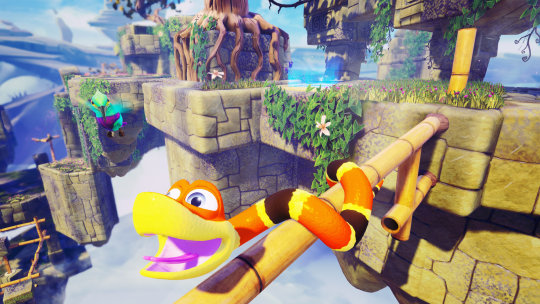
Sumo Digital has been a developer I've admired for years, particularly for their work on the Nintendo-tier kart racer Sonic & All-Stars Racing Transformed. Snake Pass is their first independently-produced title, and it has a great hook - the player controls a snake in much the same manner as a real snake might move. There's no jump button, no Earthworm Jim spacesuit, just the power to raise one's head and the strength to grip tightly to any object you've coiled around. There's no timer or enemies; Snake Pass is content to let you explore its levels at your own pace, letting you getting used to its unique feeling and take in the calming David Wise soundtrack. It's a game that feels like learning to ride a bike again, and the progression in ability over time is such a pleasing sensation that it earns it its place on this list by itself. The good use of collectables and generous helping of levels is icing on the cake.
9. Wolfenstein 2: The New Colossus (MachineGames; PS4, Xbox One, PC)
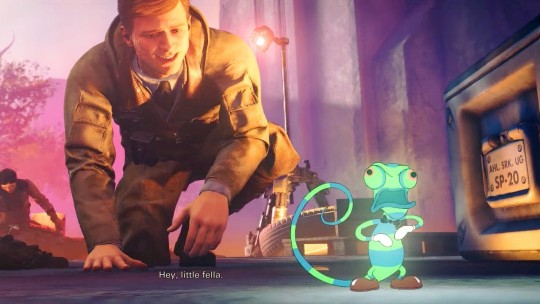
B.J. Blazkowicz returns and he's lost all meaning of subtlety whilst he's been out of action. Wolfenstein 2 shoots all of its shots - the action is bloody, explosive carnage, and the subject matter isn't satisfied with just skewering Nazi idiocy and narcissism, taking time to shine a light on White America's love affair with sitting back and reaping the rewards of compliance under fascist rule. Whether it's exploring B.J.'s broken psyche, giving Wyatt a crash course on hallucinogenics or putting you under the spotlight in a terrifying audition, MachineGames refuse to pull their punches, each great moment coming swinging like B.J.'s Nazi-reprimanding fireaxe. The combat encounters are far from polished, with stealth being heavily nerfed from The New Order and the half-way shift in tone from borderline-satirical diatribe on mortality and American race relations to comic-book capers is incredibly stodgy, but Wolfenstein 2 leaves a hell of an impression all the same. Shame about that credits music.
8. Gorogoa (Jason Roberts; PC, iOS, Nintendo Switch)

A good puzzle game can make a really strong impression, guiding you subtly by the hand to make you feel like a member of MENSA just for pressing a few buttons or prodding at a screen. With Gorogoa, I can't even begin to describe how the puzzles actually work. Imagine a window segmented with 4 panes of glass, and now imagine you can drag elements out of those panes and into other panes, or over where there isn't a pane to create a new pane... See, it’s hard! In as simple terms as I can muster, it’s a game about taking the world apart and putting it back together again to create paths and progress for your anonymous young hero. It’s intensely abstract, yet the South Asian aesthetic feels like a living locale, an exploration of a boy's days-to-come. It's a short experience, but with each puzzle solved making me feeling smarter than Albert god damn Einstein, it's one that will stick with me for a long time.
7. Splatoon 2 (Nintendo EPD; Nintendo Switch)

Like pretty much everyone, I didn't own a Wii U, but the sting of that decision never really happened until the arrival of Splatoon - Nintendo's first proper new "core" universe since what felt like Pikmin. It instantly looked like sheer fun - and as a big fan of both Jet Set Radio and The World Ends With You, it was clear as day Nintendo's younger designers were picking up the Shibuya fashion torch those games dropped behind them. Put simply, it's totally my shit. Splatoon 2 confirms my suspicions and then some, being the first multiplayer title I've enjoyed online in forever. I can't get enough of the soundtrack, the sound effects, the amazingly catty banter between Pearl and Marina, and just the feeling of dropping into ink, strafing around a sucker and blasting them straight between the eyeballs with my N-ZAP '85. 20% of Switch owners in the US can't be wrong.
6. Yakuza 0 (SEGA; PS4)
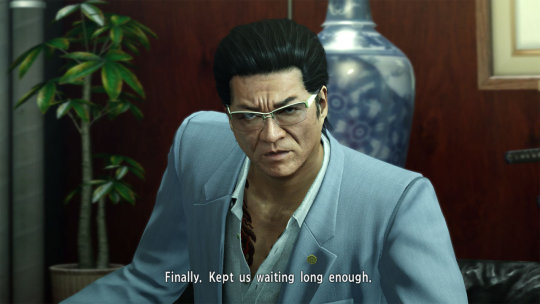
The only games I've played previously by SEGA's Toshihiro Nagoshi are the brilliant arcade/Gamecube bangers F-Zero GX and Super Monkey Ball 2, plus his one-off PS3 sci-fi shooter Binary Domain. Loving those 3 wacky games, I always felt a little put-off by his regular gig nowadays being a series about Japan's most decorated crime organisation, and a bare-knuckle brawler at that. Yakuza 0, the 80s-set series prequel that serves as a perfect entry point for series newcomers, proved my suspicions ill-founded. It's a game which instantly casts the majority of the yakuza as control freaks and bullies, pits its protagonists Kiryu and Majima as their unfounded targets and pawns... and then lets you fight your way out of hell via brutal finishing moves, bizarrely complex business management sidequests and, if you're so inclined, a gun shaped like a giant fish. It's that kind of game that always keeps you guessing whether or not you should take it seriously, and so it wins you over with its best-in-class action choreography, astonishingly good direction and a never-ending deluge of sidequests, minigames and challenges. Don't sleep on Kamurocho.
5. Sonic Mania (SEGA/Christian Whitehead/Headcannon/PagodaWest Games; Nintendo Switch, PS4, Xbox One, PC)
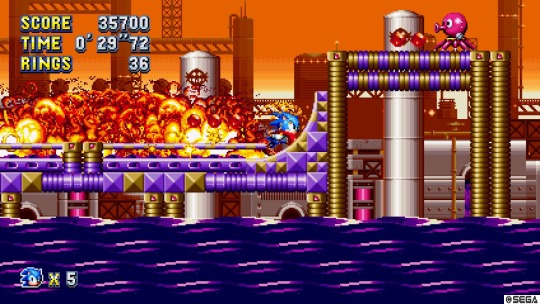
If you’re reading this, you probably know I'm a Sonic apologist. I don't really stand by the 3D entries - bar Sonic Generations, which I genuinely love - but the narrative that "Sonic was never good" is some ridiculous meme that I can't stand. They were genuinely fun games, albeit far from perfect; every game can use some improvement. Sonic Mania is that improvement, spinning the level themes and gimmicks from the original Mega Drive (and Mega CD) games into vast new forms, with myraid routes, tons of secrets, an astonishing sense of speed from beginning to end and fairer, more agreeable, more exciting level design. Old locales, new levels - oh, and some new locales as well, one of which (Studiopolis Zone) is an instant classic. 16:9 presentation, all new animations and crazy levels of animation detail, and a mind-blowing soundtrack by Tee Lopes - Sonic Mania is the perfect Sonic game.
4. NieR: Automata (Square Enix/PlatinumGames; PS4, PC)

For my first foray into the sunken mind of Yoko Taro, he couldn't have left a better impression. NieR: Automata uses Platinum's engaging-at-worst, thrilling-at-best melee combat as the language to tell his new story of how pointless it is for anyone to even bother throwing themselves after ideals of society or humanity, and why it's worth trying all the same. Every inch of this game feels crusted in Taro’s sensibilities, with the no-bullshit 2B and her curious whiny partner 9S running into robots waving white flags, avenging fallen comrades, establishing monarchies, throwing themselves to their deaths, and coming to terms with their crumbling existence in apocalypse. It's crushing, it's raw, it's often dull, but its uniquely bleak vision of AIs breaking free of their programming has a grip as powerful as a Terminator's. And when it’s ready to let you go, it has you send it off with the most memorable credits sequence in history. Glory to Yoko Taro, glory to PlatinumGames - glory to mankind.
3. The Legend of Zelda: Breath of the Wild (Nintendo EPD; Nintendo Switch, Wii U)
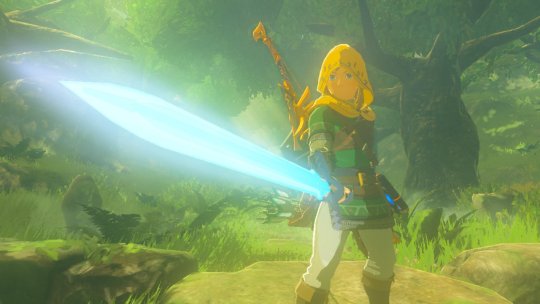
Standing in the centre of a bridge connecting Hyrule’s broad, emerald green fields to the desert mountain approach, a bridge overlooking the still Lake Hylia, I fire an arrow into a lizard bastard’s head, or at least I try to. He dodges it and rushes me, forcing me to jump away and retaliate with my claymore. Out for the count, I resume looking for the lost Zora wife I’ve been asked to seek out, who apparently washed all the way downstream in a recent downpour. I can’t see any wife - my entire view is dominated by the giant green dragon snaking across the night sky above me. The wind picks up, but I am too awestruck by its presence to take note that I could glide up to it and shoot off a valuable scale. Instead, I just stand and stare, this utterly unexpected moment happening before my eyes. Friend or foe? A boss monster, perhaps? A vital story element later on? The answer ended up being none of the above: in The Legend of Zelda: Breath of the Wild, there be dragons, and that fact in and of itself speaks volumes about what this game is about. After 30 years, Hyrule finally feels alive.
2. Night in the Woods (Infinite Fall; PS4, Xbox One, PC, Mac, Linux, Android, iOS)
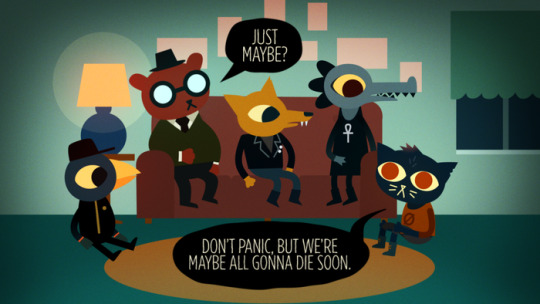
Very few games instil a genuine emotional response within me, but the story of Mae Borowski's no-fanfare return from college to suburban gloom resonates hard with me. It's an expert at the little touches - the needless-yet-fun triple jump, the not-so-starcrossed rooftop musicians, the impulsive reaction to poke a severed arm with a stick - and woefully precise with its big swings, like an upsetting cross-town party, a wave of violent frustration amongst the townspeople, and the inability to just lay it all on the table with friends and family when you need to most. In the cosmic dreams of shitty teens, Night in the Woods finds an ugly beauty in depression.
1. Super Mario Odyssey (Nintendo EPD; Nintendo Switch)
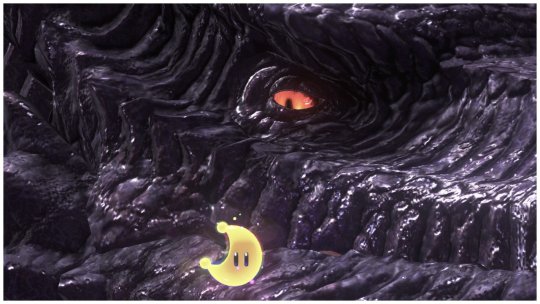
It’s impossible to deny 2017 has been the year of Nintendo. There’s plenty of celebrate elsewhere, but the Switch’s rise to prominence as the machine to be playing ideally everything on, and the amount of absolute smash hits Nintendo has producing this year makes it hard for the narrative to focus elsewhere. The epitome of all this is their final killer game of 2017: Super Mario Odyssey, the grand return of a more open-ended style of Mario platformer. A true blue achievement in joyous freedom, it brings together everything from Mario's history of 3D platforming - 64's freedom, Sunshine's other-worldliness and sky-high skill ceiling, Galaxy's spectacle, 3D World's razor-sharp platforming challenge - and throws into one big pot, creating a Mario where both the journey and the destination are one and the same, and exciting to the very end. In a year of amazing games that hit upon horrid, upsetting themes with delicate, pinpoint accuracy for tremendous success, I’m not sure whether it’s a shame or an inevitability that such an unapologetically surprising, happy game made the biggest mark on me this year, but either way, I’m welcome to have Mario be truly Super once more.
#goty#2017#splatoon2#super mario odyssey#zelda breath of the wild#yakuza 0#night in the woods#snake pass#sonic mania#gorogoa#wolfenstein#nier automata
7 notes
·
View notes
Text
Hi and welcome to part 5 of Mellz Plays KH Re:Com for the PS2
For those just joining me today here’s the previous posts about my experience thus far.
[ 1 ] _ [ 2 ] _ [ 3 ] _ [ 4 ]
We’re just about to leave the Destiny Islands and reach Sora’s endgame.
Namine meets Sora at the next floor and Sora finally starts to doubt his memory’s validity.
Namine’s proportions, and in extension, Kairi’s, terrify me pre KH2. And Repliku shows up AGAIN to try to set things straight. Ugh do I have to fight him agai- Yup I sure do! How many fights is this?!
I lost twice, then utterly obliterated Repliku with Sonic Blade, Strike Raid, and Onmislash attacks. He didnt take kindly to that and took a pot shot at Sora.
Hes REALLY fuckin ready to kill Sora oh my god. That self satisfied sigh as he relishes the moment? Yikes.

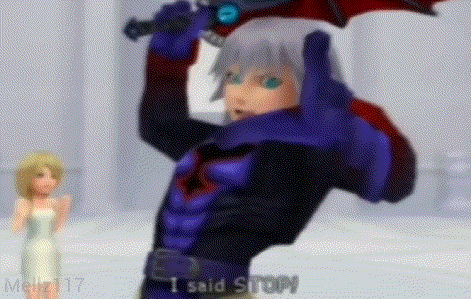
and Namine kills Repliku before he can hurt Sora! I mean, good on you honey but are you ok? Larxene appears and continues to be The Worst. All she relishes in is emotionally tormenting a literal child. She does not get better.
She yeets Repliku across the room
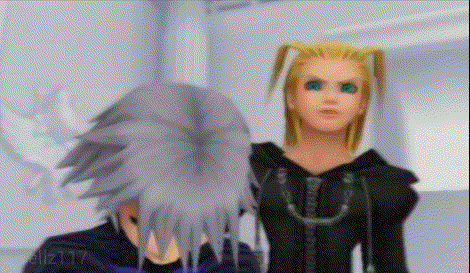
And harasses Namine
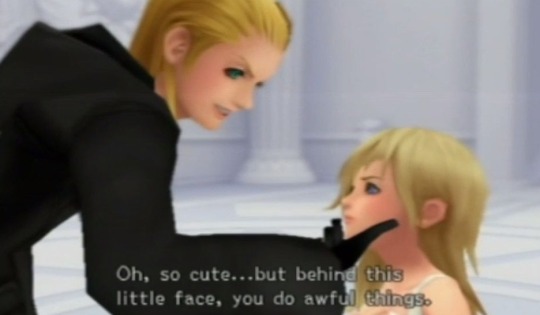
Donald and Goofy caught up with Sora.

Well yeah you only had to go up one flight of stairs, Sora hadn’t gone far, how hard could it have been to find him?
Battle! Lost three times. Larxene is such a drama queen. “I can’t believe I lost to a bunch of losers” Then what does that make you, huh Larxene? You lost, doesn’t that make you even more of a loser? Grown-ass woman calling a teenager a loser. Sounds like me lmao
So Namine explains to the gang about what she was made to do, constantly apologizing for what she did. Honey, no, Marluxia didn’t give you a choice!
Sora being an adorable, precious, wholesome dork.
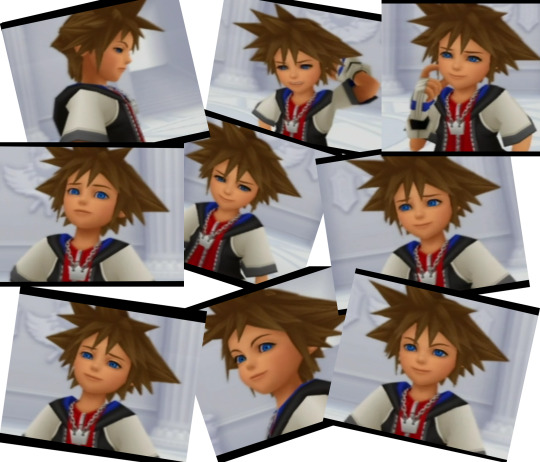
I love him so much. I would die for him. He made a promise and when he does that, he keeps them, god damn it! I missed him so much omfg—
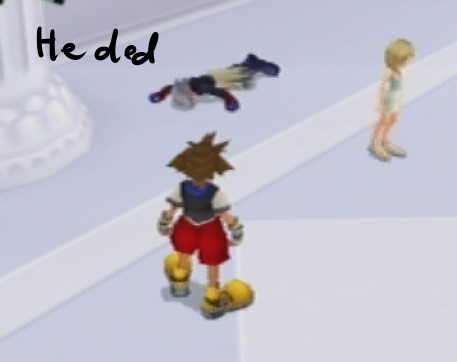
— …I’ve always had issue with how big his stupid thumb is.
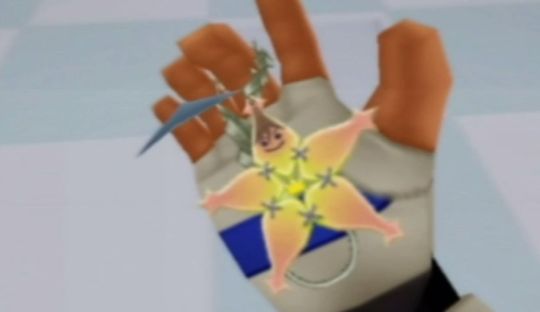
Sora, Donald, and Goofy ascended to the next floor and made “super, duper big promise” to stay friends. And that’s supposed to make them not scared…?

ALL FOR ONE AND ONE FOR ALL! READS THE SAME IN REVERSE! HELL YEAH LET’S GO!
*exploring the castle* You know for a group of people created from darkness, Org13 sure has a lot of white for their hideouts
There’s only one other person who would pay Marluxia a visit “ You have a lot of nerve to show your face around here, you treasonous bastard”.
And Axel’s like “I beg your fucking pardon? lmao”
“How long have you suspected my plan with Larxene?” Marluxia asks

They start fighting and Axel tries for a dramatic line. “The Organization’s betrayed. In that name, I will annihilate you”. What a dork.
—Axel fight! I’m expecting to have a difficult time with this one. AXEL? MORE LIKE ASS-HOLE! GOD DAMN IT! I cant ever fucking trust this stupid duck! Always using ice against an ice user, always using fire against a fire user. You’re no good, duck!
—Death count against Axel: 8 losses. Fitting as he’s the 8th member. Marluxia peaced out in the middle of the battle. He’s not interested in spectating.
I got a little lost. I ended up going in a circle trying to get back to where Axel and Marluxia fought because I’m dumb. I can get lost in an open field with one exit. It was a Naruto Shippuden game…
“Namine, erase Sora’s memory”. This begs the question; Can’t she erase MARLUXIA’S memory? I mean, it’s not like he’d know…
“A-hyuck we can remember everything for Sora!” Yeah you’ve done a great job up until this point /s
Repliku shows up. Marluxia doesn’t like that. I thought Nobodies didn’t have emotions? Oh wait wasn’t that retconned or something in KH3D? idk lmao
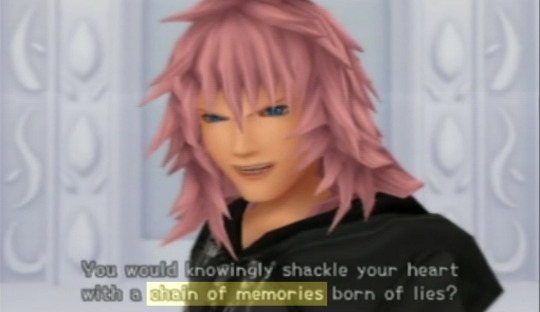
Ohp! He said it! He said the title of the game!
Marluxia battle death count: 3. He only had half a bar left on my 2nd death. What matters is that we won. Oh wait, just an illusion. Fuck you Marluxia. an illusion. Eat a dick.
Sora doesn’t hold grudges. He trusts Repliku to keep Namine safe. That’s so sweet. So precious. It may not actually be Riku but Sora don’t care. He loves all his friends, imitation or not.
This reminds me of Salazar in RE4, when he was eaten up by a giant plaga infected plant and became a boss monster.
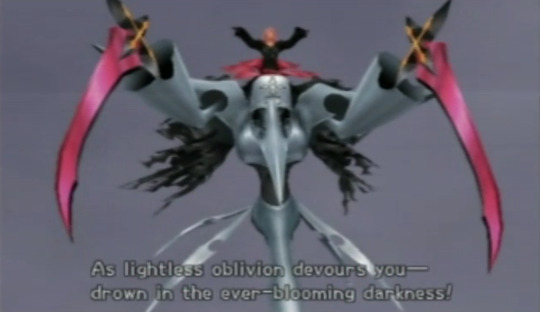
Huh I only lost once on the final battle…
WAIT NEVER MIND! I forgot Kingdom Hearts bosses have MAAAAANY phases! First try on the final phase and I won. He gets easier and easier as his phases progress. Shouldn’t it be the other way around? Nah he’s just getting worn down. These transformations take up a lot of energy. He’s tired.
Upon Marluxia’s death, Sora watches him fade away. With a scowl on his face, he leaves the battle arena (how he does this I have no idea). Savage.
The trio meets up with Namine and Repliku. “All I remember is my time with you and Namine" says Repliku. Not like his time with Sora was in any way positive. But regardless, they’re his. After a few more exchanges, he leaves the group.
Namine offers to put Sora’s memories back in order. After a few painful moments of contemplation, Sora makes his choice. “Make me like I was.” He decides, with the SADDEST expression on his face.

---So like, WHAT is with this pod? We know what Namine uses it for but why does it exist, assuming she’d never have to return someone’s true memories? It serves exactly ONE purpose and it’s not what Marluxia wanted.
“I’ll write a memo to thank Namine!” Jimmy pipes up. Well why can’t Jimmy JUST WRITE EVERYTHING ELSE THAT TRANSPIRED IN THIS GAME IN HIS JOURNAL FOR FUTURE SORA?
During the credits scene, we get a few clips. In one we see Repliku is absolutely Not Content with his situation. Axel appears before him and offers his hand.
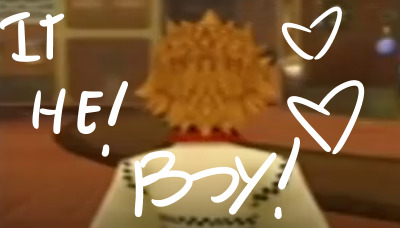
I feel so emotional about the poem at the end of the credits
It took me 32 hours and 30 minutes to complete Sora’s campaign. On to Riku’s. See you there? I’ll link part 1 when it’s ready.
There is always sleep between part and meet with our usual words on the usual street. So let us part like we always do… And in a world without you I’ll dream of you. When I come to, let us meet with our usual words on the usual street.
#mellz plays kh recom#Kingdom Hearts series#kingdom hearts re:chain of memories#square enix#Playstation 2#kh recom#mellz post
0 notes
Text
Splendid isolation: how I stopped time by sitting in a forest for 24 hours
https://www.theguardian.com/news/2020/jan/24/wilderness-solo-splendid-isolation-stopped-time-sitting-in-a-forest-24-hours
My life seemed to be getting busier, faster: I felt constantly short of time – so I stepped outside it for a day and a night and did nothing.
By Mark O’Connell
Fri 24 Jan 2020 06.00 GMTLast modified on Tue 28 Jan 2020 09.56 GMT
It was early summer, and I was on the verge of turning 40. I found myself entertaining a recurring daydream of escaping from time. I would be hustling my son out the door to get him to school, or walking briskly to work on the day of a deadline, or castigating myself for being online when I should have been methodically and efficiently putting words on paper, and I would have this vision of myself as a character in a video game discovering a secret level. This vision was informed by the platform games I loved as a child – Super Mario Bros, Sonic the Hedgehog and so on – in which the character you controlled moved across the screen from left to right through a scrolling landscape, encountering obstacles and adversaries as you progressed to the end of the level. In this daydream, I would see myself pushing against a wall or lowering myself down the yawning mouth of a pipe, and thereby discovering this secret level, this hidden chamber where I could exist for a time outside of time, where the clock was not forever running down to zero.
My relationship with time had always been characterised by a certain baleful anxiety, but as I approached the start of the decade in which I would have no choice but to think of myself as middle-aged, this anxiety intensified. I was always in the middle of some calculation or quantification with respect to time, and such thoughts were always predicated on an understanding of it as a precious and limited resource. What time was it right now? How much time was left for me to do the thing I was doing, and when would I have to stop doing it to do the next thing?
This resource being as limited as it was, should I not be doing something better with it, something more urgent or interesting or authentic? At some point in my late 30s, I recognised the paradoxical source of this anxiety: that every single thing in life took much longer than I expected it to, except for life itself, which went much faster, and would be over before I knew where I was.
Much of this had to do with being a parent. Having two young children had radically altered my relationship with the days and hours of my life. Almost every moment was accounted for in a way that it had never been before. But it was also the sheer velocity of change, the state of growth and flux in which my children existed, and the constant small adjustments that were necessary to accommodate these changes. I would realise that my son no longer mispronounced a particular word in that adorable way he once had, or that his baby sister had stopped doing that thing of nodding very seriously and emphatically when she heard a song she liked – that she was, in fact, no longer a baby at all – and that those eras had now passed for good, along with countless others that would pass unnoticed and unremembered, and I would feel sad and remorseful about not having lived more fully in those moments, not having stopped or at least slowed the flow of time. And when I felt this way, I would succumb to the daydream of the video game, the secret level, the escape from time itself.
My son turned six around then, itself a significant milestone in that he was, for the first time, at an age I myself could dimly remember being. And with this new phase of parenthood, I began to think how strange it was, given how precious those early years now seemed to me, that I spent so little time thinking about my own childhood, the lost civilisation on which my adult self now stood. The motion of the video game unfurled rightward, and I had no choice but to follow its motion towards the future, towards the completion of the game itself.
And then one day, about a week and a half before I turned 40, I found myself alone in a forest in Devon, where I discovered this secret level of my daydreams.
Here is how I did it: I came to a clearing in a forest by a riverbank in Dartmoor national park, far enough from any trail that it seemed unlikely I would encounter anyone while I was there. I gathered some loose branches and stones and arranged them in a circle of about 10 metres in diameter, and then I walked into the circle and did not leave it until the same time the following day.
The short version of this story is that nothing happened in that time: that I did nothing and witnessed nothing, experienced only the passage of the hours and minutes, and the languid dynamics of my own boredom. The long version isn’t exactly The Iliad, either, but in that version something could be said to have happened. Because by the time I walked out of that circle the following afternoon, I’d had an entirely unexpected and intensely cathartic encounter with the passage of time, and with my own mortality.
This is a practice commonly referred to as a “wilderness solo”. The basic principle is that you go out into nature, the wilder and more remote the better, and confine yourself to one very small area for a set period – a day, two days, three days, sometimes longer. During this period, you forego anything that might come between yourself and your own solitude. No phone. No books or other reading material. You don’t build a fire, because building a fire is a way to keep yourself busy, watching the dance of its flames a primitive entertainment. Most participants choose not to bring food, because when you have got nothing to do for a day and a night, the prospect of eating a sandwich can easily become an all-encompassing preoccupation, undermining the entire project of unmediated communion with nature. After that period of immersion, you step outside of your circle, and you re-enter the world.
Until fairly recently, I was not a person who had a lot of time for nature. I wished it well in all its dealings, and was glad to take its side in any quarrel with the forces arrayed against it, but my regard for it was essentially abstract, and I would just as soon have left it to its own devices. Nature was something I encountered as scenery, an experience to be consumed before getting back in the car and continuing on my way. But about the middle of 2016, amid the endlessly unfurling horrors of that year’s news, I became increasingly preoccupied with how this darkening political reality seemed to foreshadow a near future defined by a permanent state of climate emergency. And these things felt connected in some way that resisted easy definition: the speed and efficiency with which technology was gutting democracy and alienating us from the reality of human suffering, and the increasing extremity of our estrangement from the natural world. I was thinking all the time about climate change, about the future my children would be forced to live in, about what we had done and were continuing to do to the world. But at some point it dawned on me that I didn’t know the first thing about that world. What I knew was the great indoors in which I lived my life: the insides of buildings, the insides of books, the interlocking interiors of the internet and my own mind. When I talked about nature, I didn’t know what I meant. In a way that was somehow both vague and urgent, I felt that it was time to go outside.
I came across an organisation called Way of Nature UK that arranged group wilderness retreats, and I signed up for a trip. This was how, in the spring of 2017, I ended up spending a week with a group of about 20 other people in a remote wilderness reserve called Alladale in the Scottish Highlands, towards the end of which everyone went off to various locations and did a solo. How did I feel about sitting by a river for 24 hours and doing absolutely nothing, aside from looking at grass and clouds and water and so on? I felt slightly intimidated. I felt uncomfortable. I felt, above all, reflexively cynical, in the way that I was reflexively cynical about pretty much anything that felt new-agey or hippyish or otherwise overly earnest to me. But over the course of that week, and in particular the 24 hours I spent alone by the river, that brittle carapace of cynicism began to give way. What affected me most deeply about that time alone in nature was the aspect of it I had initially been most daunted by. The experience of the solo is the experience of time itself, in its rawest and most unmediated form.
When I stepped into that ad-hoc ceremonial circle in Devon last summer, it had been over a year since I had performed the ritual, and I found myself craving the solitude and immersion it provided.
Andres Roberts, Way of Nature’s co-founder, picked me up that morning outside my hotel in Bristol, near where he lives. I had got to know him pretty well on the two previous trips I had done with him, and my new enthusiasm for spending time alone in nature had been informed by his quietly ecstatic way of talking about the wilderness. As we drove south along the M5 through intermittent downpours of rain, he spoke about his work, and the ideas underpinning it. If there was a single word that encapsulated the value he was trying to incubate, that word was “slowness”. There was an extraordinary transformative power, he insisted, in the practice of sitting and doing nothing, and thereby slowing your mind and body to a meditative rhythm in nature.
One of Roberts’s major themes was the idea that our particular civilisation, at our particular time, was unusual in not having as part of its cultural repertoire some ritual whereby during periods of change or upheaval people went out alone into nature. When he talked about the practice of the wilderness solo, he talked about it in such terms – as a ritual whereby you stepped out of the flux of the world, in order to gain some perspective on the flux, and your place within it.
A word he used a lot in talking about his work, and in describing the experience and value of the nature solo, was “re-enchantment”. He was of the opinion that most people, most of the time, lived life in a state of disenchantment. What he wanted to do, above all, was to help people strip away the layers of hard rationalism that accrued around the adult mind, so that they could return to a more childlike engagement with the world. And in reaching this state, he said, this place of re-enchantment, we could come to see ourselves not as separate from and in control of nature, but as part of it.
It was harder than anticipated, finding a solo spot. We had settled on Dartmoor for its proximity to Bristol and its relatively humane weather outlook, but it was not a place with which Roberrts was particularly familiar. We followed at first a northward trail, planning to cross a footbridge into deeper forest on the far side of the river, but when we eventually found it, the gate to the footbridge was firmly padlocked.
Further along the trail we met a man out for a walk with his dog. Early 70s, bearded, wax jacketed, he wore the dog’s lead draped athwart himself shoulder to hip in the manner of a mayoral sash. Roberts asked him whether there was a bridge we could cross further on. He shook his head and courteously informed us, in a Devonshire accent as soft and mulchy as the ground beneath our feet, that we were on land privately owned by one of his neighbours, and that the more densely forested territory across the river was private, too, and that we technically required a permit to walk this trail.
We turned and strolled back with him toward the road, and as he chatted to us about the cottage he and his wife had recently renovated, and their troubles with the local conservation society who disapproved of their alterations to the property, I was struck by how easily the concept of private land ownership could be made to feel absurd. It seemed perfectly rational in towns and cities, in housing estates and apartment buildings, for people to own their little portions of the world. But here, on the flourishing banks of a torrential river, the thought that this place was the sole property of some mere person – that that person could own the deeds to a river bank or a forest – seemed deeply and disorientingly counterintuitive, in a way that threatened to undermine the whole spirit of our enterprise. It felt impossible, as I put it to Roberts after we parted company with the man, to pursue the kind of immersive experience of a place we were after when you worried you might be trespassing.
“Yes,” he said. “Although this is England. Literally half of the land in this country is owned by less than 1% of the population. A handful of aristocrats and corporations.”
He reassured me, though, that we would find a suitable place for my solo, on commonly owned land where I wouldn’t have to worry about some local squire coming along and telling me I had no business having an immersive experience with his privately owned nature.
We found another trail, running northward along the River Dart. Roberts lowered his voice to not much more than a whisper, eventually stopping talking altogether, and slowed his pace so that I was walking well ahead of him. I understood this deliberate minimisation of his own presence to mean that we had entered a kind of buffer zone between the outside world and the solo space. This was one of the great charms of how he worked; without his having seemed to do anything very specific, you were made to understand that some ritual was underway, that you were somehow in the midst of the sacred.
The point of being here is to be here. An hour or two into my time in the forest, I wrote these words in my notebook, and drew a box around them to emphasise their authority and self-sufficiency. And then I stopped writing words in my notebook altogether, because writing words is my work, and I was wary of taking an utilitarian approach to the solo. The point of being there, after all, was to be there. (The cynical reader might argue that the point of being there was to write about being there – an argument the cynical writer will, on balance, concede, if only to avoid getting bogged down in the ontological complexities of the whole relationship between experiencing things and writing about them.)
And what did I do, while I was being there, in the forest, by the river? Nothing, more or less. The first half hour or so, there was a certain amount of housekeeping to attend to. I had to find exactly the right spot: not too damp; flat enough to pitch a tent once night began to fall; sheltered from the elements, but not so sheltered as to obscure the view of the river and the far bank. I had to mark out the circle, of course. I had to gather flat stones and sticks and bits of branches, and arrange them around a beech tree I had chosen as the central feature of my location. It could, I suppose, have been an oak tree, or an elm, or some other type of lofty deciduous of which I, being no Robert MacFarlane, had no prior knowledge.
But once all that was out of the way, I had to confront that fact of having nothing to do. In theory, I should have greeted this experience with open arms. I had, in fact, been looking forward to it for weeks – to having no tasks to attend to, no places to go, no obligations to meet. Here I was with nothing to do but inhabit the spaciousness of every passing moment, to bathe at leisure in the pooled flow of time itself. In theory, it was the dream. In practice, if I could have taken out my phone and gone on Twitter I surely would have. (Thankfully, this possibility was foreclosed to me by the fact of having no mobile coverage. In any case, I’d stowed my phone in my backpack in order to stop myself violating the spirit of the wilderness solo by spending the whole time looking through photos of my children, or opening up the New Yorker app and immersing myself not in nature, but in back issues of a magazine I never had the time to read, for reasons gestured at above.)
When you’re actually in it, the reality of the solo is, at least at first, one of total boredom. I cannot stress enough how little there is to do when you have confined yourself to the inside of a small circle of stones and sticks in a forest. But it is an instructive kind of boredom, insofar as boredom is the raw and unmediated experience of time. It is considered best practice not to have a watch, and to turn off your phone and keep it somewhere in the bottom of a bag so as to avoid the temptation to constantly check how long you’ve been out and how long you have left. And as you become untethered from your accustomed orientation in time – from always knowing what time it is, how long you have to do the thing you’re doing, when you have to stop doing it to do the next thing – you begin to glimpse a new perspective on the anxiety that arises from that orientation. Because this anxiety, which amounts to a sort of cost-benefit analysis of every passing moment, is a quintessentially modern predicament.
As weirdly counterintuitive as it feels to acknowledge, human beings are not naturally predisposed to think of life in terms of seconds and hours, of how they might be optimised. The development of mechanical clocks during the middle ages and, later, the advent of widespread precision timekeeping that facilitated the industrial revolution, fundamentally changed the way in which the human animal related to the world. Time became both an abstraction and a commodity, a raw material to be bought and sold, saved or squandered.
The mass adoption of this new conception of time, abstract and removed from the organic context of nature, was central to the rise of capitalism, and to the accelerating mechanisation of life. “Beginning in the 14th century,” as the American cultural critic Neil Postman put it, “the clock made us into time-keepers, and then time-savers, and now time-servers. In the process, we have learned irreverence toward the sun and the seasons, for in a world made up of seconds and minutes, the authority of nature is superseded.” To sit by a river for a day and a night is to experience the reinstatement, if only temporarily, of that authority.
What did I do, sitting in that forest? I drank a lot of water, because I had brought a lot of water, and drinking it was, if only in the most basic of senses, something to do. And because I drank a lot of water, I took a great many resulting pisses around the far side of the tree, and this too presented something to do, however minor. I would occasionally treat myself to a bit of a stand, or even a little stroll around my circle, but mostly I was content to sit propped against my backpack with my legs spread before me on the soft carpet of leaves. I spent a lot of time looking at those leaves: holding them up to the light, observing the delicate webbings, the desiccated veins, crumbling them slowly between my fingers. This, I admit, was only slightly more interesting than doing nothing at all.
The tree, in time, became a central object of my attention. I can’t say how long I spent standing in front of its trunk, staring at its covering of bright green moss, its gnarled protuberances of bark, but it must have been at least an hour. The moss was leafy, and felt both delicate and spongily resilient beneath my hand, and the longer I stared at it, the more I came to feel that I was gazing downward from a great height at a forest, that the moss was a canopy of leaves and the bark the ground beneath. The surface of the tree was its own ecosystem, expansive and intricate, and when I looked closely enough I saw that there were tiny insects everywhere, spiders and other many-legged creatures, whom I imagined living out their days aware of no other world than that little vastness, that forest within a forest.
My own incapacity to give this tree a name seemed suddenly strange to me, and slightly sad. In the ordinary run of things, if I were curious enough about what kind of tree I was looking at, I would have just gone on Google, or downloaded one of those tree-recognising apps, but this option was not available to me. Then it occurred to me that there was something about the not knowing that was somehow right. Not having a human name to give the tree, a category in which to put it, made the tree more real and present to me than it otherwise would have, or so I allowed myself to believe.
At some point it came to my attention that I was no longer bored, and that I had not been bored for some time. This is not to say that I was in a state of high mental stimulation, but that the hours of inactivity had induced in me a kind of meditative stupor, whereby I was receptive to the information of the environment – to the ceaseless clamour of the river, the chattering of the birds overhead, the urgent whisperings of the leaves in the breeze, the modulations of temperature and light – but uninclined to think much about this information, or anything else. I had, I realised, become attuned to the frequencies of the forest. I had found the secret level.
This is a thing that has happened to me whenever I have been alone in nature for an extended period: there occurs, some hours in, a subtle but profound modulation in consciousness whereby I come to experience myself as part of the place I am in, as an organism among organisms. This is a state of mind in which I can watch a small spider crawl along my arm for many minutes, feeling a kind of sentimental fellowship with this busy, delicate creature, whom in the normal run of things I would not hesitate to brush off in irritation or disgust.
In these moments, I find myself thinking of the place itself as somehow conscious of my presence. To be alone in a forest, and to be thinking of the forest as somehow aware of you: I will acknowledge that this sounds like the very substance of nightmare, but, in fact, it is a strangely beautiful and quietly moving experience, and I think it must be what people mean when they talk about intuiting the presence of God.
The word that comes to mind is immanence – a term I learned as a philosophy undergraduate and which I did not remotely understand until I began to have these experiences of being alone in nature. In his 1836 essay Nature, American poet Ralph Waldo Emerson identifies precisely this sublime phenomenon. “The greatest delight which the fields and woods minister,” he writes, “is the suggestion of an occult relation between man and the vegetable. I am not alone and unacknowledged. They nod to me, and I to them.” It’s a phenomenon that he views as both an apprehension of the divine and a return to the child’s perception of the world. “In the woods,” he writes, “a man casts off his years, as the snake his slough, and at what period soever of life, is always a child.”
I am struck now by how strongly these lines of Emerson – these ideas of casting off years, of attaining the spirit of early childhood – resonate with the strangest and most unsettling and, in the end, most wonderful aspect of my experience in the woods. While I was there, I didn’t spend much time thinking about reaching 40, and whatever lay beyond. What I thought about was the distant past of my own childhood, which I spent in the countryside, in a house beside a small wood with a little stream running through it: a tamely arcadian surrounding which provided the setting for countless imagined adventures, battles and voyages. Something about sitting alone among the trees, looking at the river, put me in mind of that period of my life. The fact of having all this time now, and nothing to do with it; the slow process by which intense boredom had given way to a kind of absent-minded and playful immersion: these were things I associated with my own childhood. I remembered what Andres Roberts had said about re-enchantment, about time in nature as a means of returning to a more childlike engagement with the world.
And then for a long time I thought about my son, of how he existed in a thin space between reality and fantasy. I thought of how attached he was to his favourite toy, a small brown rabbit he carried everywhere with him, clutched in the crook of an arm, of how real and alive that rabbit was to him. This was in my mind because the previous evening, as I had unpacked at my hotel, I saw that my wife had slipped among my camping things a stuffed rabbit I myself had been deeply attached to when I was small. She had found it on a recent visit to my parents’ house, where it had been lying around for years in my childhood bedroom. That rabbit, with its floppy long limbs and its black button eyes and its faded blue dungarees, had been as real to me, as invested with surplus love, as my son’s stuffed rabbit now was to him. I thought of how soon – a year from now, or maybe less – my son’s rabbit would stop being real to him, how soon his world would lose the magic he himself had breathed into it.
And I thought with a pang of how I was always hurrying him – to get dressed, to get out the door for school, to finish his dinner, to get ready for bed – and of how heedlessly I was inflicting upon him my own anxious awareness of time as an oppressive force. How before he knew where he was, his own childhood would have receded into the past, and he too would be out of the secret level of childhood and into the laterally scrolling world of adulthood.
As the sun was going down in Dartmoor, I put up my tent and, in the dwindling light of the forest, rummaged in my backpack for my head-mounted torch. Inside the backpack, my hand encountered again the familiar softness of the stuffed rabbit. I held the toy a moment, smiled again at this touching and witty gesture of my wife’s, and then decided to take a photo of it to send to her when I had mobile coverage the following day. I propped the rabbit against the outer lining of the tent and turned away to rummage again in my bag for my phone, and when I turned back I was overcome by a shock of recognition. I was seeing the rabbit not as I had seen it a moment before, as an intriguing relic of the submerged civilisation of my childhood, but as I had seen it as a small boy.
The rabbit was entirely alive to me in that moment. It was as though all the love I had invested in this object in those days was still contained within it, within him, and the experience of its sudden animation was overwhelming. I was looking at the rabbit, and the rabbit was looking at me, and it was seeing me, and I was both myself and the child I had once been. Whatever complex of emotions I was feeling was neither sentimental nor nostalgic in character, but powerfully existential. I felt simultaneously closer to myself as a child than I had in all the years of adulthood, and yet that sudden closeness came as an experience of loss, of immeasurable distance. It was as though time had folded in on itself, and the present was touching the past. There I was, as close to 40 as made no difference, alone in a forest on a moonless night and weeping with cathartic abandon at the sight of a threadbare stuffed animal. I was mourning my childhood, and the mourning felt long overdue.
I woke early, and lay still for a time listening to water dropping from the branches and leaves onto the outer layer of my tent. I had slept more soundly than I had expected, given the hard ground beneath me and the mummifying strictures of the sleeping bag. The absolute darkness and solitude had aroused neither loneliness nor unease. I had felt strangely at home with the sounds and silences of the forest at night.
Until very recently, the idea of spending a rainy morning alone in a forest would have been a profoundly unattractive one, but I found myself relishing the prospect of these last hours. The restlessness I had experienced the previous day, in that last stretch of the solo, was entirely absent now, the question of what to do with myself for several hours having come to seem nowhere near as pressing. The idea of such a question felt, in fact, somehow absurd. I went to the edge of my circle and sat down, and looked at the river.
You would have thought that I’d have been more or less done with looking at the river by now, but in fact I was eager to get stuck into it again after the long night-time hours of not looking at the river. In terms of the diversions that were presently available to me, looking at the river was the hottest ticket in town. And so I sat there at the edge of my little circle on the riverbank and binge-watched the river. There is, it turns out, a lot going on at any one time in a river, especially if you’ve got nothing else to be looking at.
There were birds coming and going all the time, skimming low over the water and landing on the banks. There was the occasional ambiguous shape flitting on the periphery of my vision that may well have been some kind of leaping fish. I attended in particular to a bit of river directly in front of me where the water plunged low into a sort of miniature waterfall, immediately after which it appeared to run backward into itself, a phenomenon I couldn’t begin to try to account for, but for which the most likely culprit seemed to be gravity. I stared at this spectacle for so long that a kind of optical illusion began to assert itself, whereby when I glanced up at the opposite bank, the long grass and drooping ferns seemed themselves to be engaged in sympathetic movements, swirling impossibly before my eyes. It could have been the effect of hours of meditative inactivity, or it could just have been hunger, but there was something mildly trippy about the experience.
Around noon, I heard a gently insistent bird call coming from a little way upriver. I turned toward it, and saw Roberts standing not far off with his back against a tree trunk, making an owl sound with his hands cupped to his mouth. I gathered my things, and we walked in silence out of the forest, him keeping several paces behind me. This seemed both entirely deliberate and entirely natural, and its effect was to preserve a measure of my solitude as I gradually emerged from the circle, out of the secret level and back into time.
0 notes